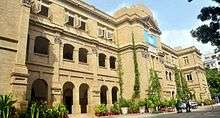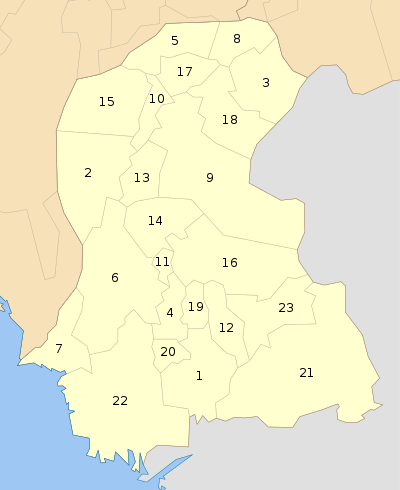Karachi
| Karachi ڪراچي کراچی | |
|---|---|
| Metropolis | |
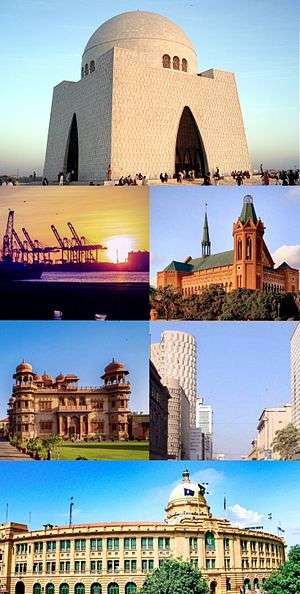 | |
| Nickname(s): City of the Quaid,[1] Paris of Asia,[2][3] The City of Lights,[2] Bride of the Cities[4][5] | |
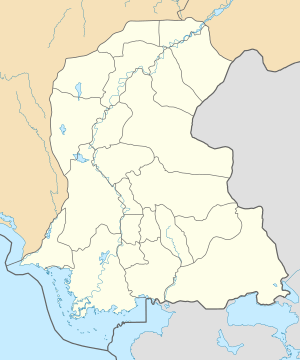 Karachi ڪراچي Location in Pakistan  Karachi ڪراچي Karachi ڪراچي (Pakistan)  Karachi ڪراچي Karachi ڪراچي (Asia) | |
| Coordinates: 24°51′36″N 67°0′36″E / 24.86000°N 67.01000°ECoordinates: 24°51′36″N 67°0′36″E / 24.86000°N 67.01000°E | |
| Country | Pakistan |
| Province | Sindh |
| Metropolitan Corporation | 2011 |
| City Council | City Complex, Gulshan-e-Iqbal Town |
| Districts[6] | |
| Government[7] | |
| • Type | Metropolitan City |
| • Mayor | Waseem Akhtar (MQM-P) |
| • Deputy Mayor | Arshad Vohra (PSP) |
| Area[8] | |
| • Total | 3,780 km2 (1,460 sq mi) |
| Elevation | 8 m (26 ft) |
| Population (2017 Census - Provisional)[9][10] | |
| • Total | 14,910,352 |
| • Rank | 1st in Pakistan |
| • Density | 3,900/km2 (10,000/sq mi) |
| Demonym(s) | Karachiite |
| Time zone | UTC+05:00 (PST) |
| Postal codes | 74XXX – 75XXX |
| Dialing code | +9221-XXXX XXXX |
| GDP/PPP | $113 billion (2014)[11] |
Karachi (Urdu: کراچی; ALA-LC: Karācī, IPA: [kəˈraːtʃi] (![]()
Though the Karachi region has been inhabited for millennia,[20] the city was founded as the fortified village of Kolachi[21] in 1729.[22] The settlement drastically increased in importance with the arrival of British East India company in the mid 19th century, who not only embarked on major works to transform the city into a major seaport, but also connected it with their extensive railway network.[21] By the time of the Partition of British India, the city was the largest in Sindh with an estimated population of 400,000.[19] Following the independence of Pakistan, the city's population increased dramatically with the arrival of hundreds of thousands of Muslim refugees from India.[23] The city experienced rapid economic growth following independence, attracting migrants from throughout Pakistan and South Asia.[24]
Karachi is one of Pakistan's most secular and socially liberal cities.[25][26][27] It is also the most linguistically, ethnically, and religiously diverse city in Pakistan.[19] With a population of 14.9 million recorded in the 2017 Census of Pakistan,[10] Karachi is the world's 6th most populous metropolitan area.[28][29] Karachi is one of the world's fastest growing cities,[30] and has communities representing almost every ethnic group in Pakistan. Karachi is home to over 2 million Bangladeshi immigrants, 1 million Afghan refugees, and up to 400,000 Rohingyas from Myanmar.[31][32][33]
Karachi is now Pakistan's premier industrial and financial centre. The city has a formal economy estimated to be worth $113 billion as of 2014.[34] Karachi collects over a third of Pakistan's tax revenue,[35] and generates approximately 20% of Pakistan's GDP.[36][37] Approximately 30% of Pakistani industrial output is from Karachi,[38] while Karachi's ports handle approximately 95% of Pakistan's foreign trade.[39] Approximately 90% of the multinational corporations operating in Pakistan are headquartered in Karachi.[39] Up to 70% of Karachi's workforce is employed in the informal economy,[40] which is typically not included in GDP calculations.[41]
Known as the "City of Lights" in the 1960s and 1970s for its vibrant nightlife,[42] Karachi was beset by sharp ethnic, sectarian, and political conflict in the 1980s with the arrival of weaponry during the Soviet–Afghan War.[43] The city had become well known for its high rates of violent crime, but recorded crimes sharply decreased following a controversial crackdown operation against criminals, the MQM political party, and Islamist militants initiated in 2013 by the Pakistan Rangers.[44] The city's murder rate in 2015 had decreased by 75% compared to 2013, and kidnappings decreased by 90%,[45] with the improved security environment triggering sharp increases in real-estate prices.[46]
Etymology
Karachi was reputedly founded in 1729 as the settlement of Kolachi.[22] The new settlement is said to have been named in honour of Mai Kolachi, whose son is said to have slain a man-eating crocodile in the village after his elder brothers had already been killed by it.[22]
The city's inhabitants are referred to by the demonym Karachiite in English, and Karāchīwālā in Urdu.
History
Early history
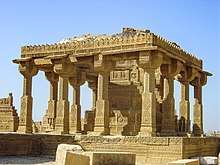
Late Palaeolithic and Mesolithic sites discovered by a team from Karachi University on the Mulri Hills constitute one of the most important archaeological discoveries made in Sindh during the last 50 years. The earliest inhabitants of the Karachi region are believed to have been hunter-gatherers, with ancient flint tools discovered at several sites. A sea port called Barbarikon by the Greeks was situated in Karachi.
The Karachi region is believed to have been known to the ancient Greeks. The region may be the site of Krokola, where Alexander the Great once camped to prepare a fleet for Babylonia, as well as Morontobara which may possibly be Karachi's Manora neighbourhood.
In 711 CE, Muhammad bin Qasim conquered the Sindh and Indus Valley. The Karachi region is believed to have been known to the Arabs as Debal, from where Muhammad Bin Qasim launched his forces into South Asia in 712 C.E.[47]
Under Mirza Ghazi Beg, the Mughal administrator of Sindh, the development of coastal Sindh and the Indus delta was encouraged. Under his rule, fortifications in the region acted as a bulwark against Portuguese incursions into Sindh. The Ottoman admiral, Seydi Ali Reis, mentioned Debal and Manora Island in his book Mir'ât ül Memâlik in 1554.
Kolachi settlement
Karachi was founded in 1729 as the settlement of Kolachi under the rule of the ethnically Baloch Talpur Mirs of Sindh.[22] The founders of the settlement are said to arrived from the nearby town of Karak Bandar after the harbour there silted in 1728 after heavy rains. The settlement was fortified, and defended with cannons imported by Sindhi sailors from Muscat, Oman. The name Karachee was used for the first time in a Dutch document from 1742, in which a merchant ship de Ridderkerk is shipwrecked near the original settlement.[48][49] The city continued to be ruled by the Talpur Mirs until it was occupied by forces under the command of John Keane in February 1839.[50]
British Raj
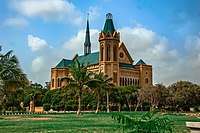
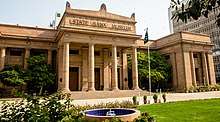
The British East India Company captured Karachi on 3 February 1839 after HMS Wellesley opened fire and quickly destroyed the local mud fort at Manora.[51] The town was annexed to British India in 1843 after Sindh was captured by Major General Charles James Napier in the Battle of Miani, with the city declared capital of the new British province.
The city was recognized for its strategic importance, prompting the British to establish the Port of Karachi in 1854. Karachi rapidly became a transportation hub for British India owing to newly built port and rail infrastructure, as well as the increase in agricultural exports from the opening of productive tracts of newly irrigated land in Punjab and interior Sindh.[52] The British also developed the Karachi Cantonment as a military garrison in order to aid the British war effort in the First Anglo-Afghan War.[53]
During the Sepoy Mutiny of 1857, the 21st Native Infantry, then stationed in Karachi, mutinied and declared allegiance to rebel forces in September 1857, though the British were able to quickly defeat the rebels and reassert control over the city. Following the Rebellion, British colonial administrators continued to develop the city. In 1864, the first telegraphic message was sent from South Asia to England from Karachi.[54] Public building works were undertaken, including the construction of Frere Hall in 1865 and the later Empress Market. In 1878, the British Raj connected Karachi with the network of British India's vast railway system.
By 1899, Karachi had become the largest wheat-exporting port in the East.[55] British development projects in Karachi resulted in an influx of economic migrants from several ethnicities and religions, including Anglo-British, Parsis, Marathis, and Goan Christians, among others. Karachi's newly arrived Jewish population established the city's first synagogue in 1893.[56] Muhammad Ali Jinnah, the founder of Pakistan, was born in Karachi's Wazir Mansion in 1876 to migrants from Gujarat. By the end of the 19th century, Karachi's population was estimated to be 105,000.[57]
Under British rule, the city's municipal government was established. Known as the Father of Modern Karachi, mayor Seth Harchandrai Vishandas led the municipal government to improve sanitary conditions in the Old City, as well as major infrastructure works in the New Town after his election in 1911.[2]
Post-independence
At the dawn of Pakistan's independence in 1947, Karachi was Sindh's largest city with a population of over 400,000.[19] Despite communal violence across India and Pakistan, Karachi remained relatively peaceful compared to cities further north in Punjab.[2] The city became the focus for the resettlement of Muslim Muhajirs migrating from India, leading to a dramatic expansion of the city's population. This migration lasted until the 1960s.[58] This immigration ultimately transformed the city's demographics and economy.
Karachi was selected as the first capital of Pakistan and served as such until the capital was shifted to Rawalpindi in 1958.[59] While foreign embassies shifted away from Karachi, the city is host to numerous consulates and honorary consulates.[60] Between 1958 and 1970, Karachi's role as capital of Sindh was ceased due to the One Unit programme enacted by President Iskander Mirza.[2]
Karachi of the 1960s was regarded as an economic role model around the world, with Seoul, South Korea borrowing from the city's second "Five-Year Plan."[61][62] The 1970s saw major labour struggles in Karachi's industrial estates. The 1980s and 1990s saw an influx of thousands of Afghan refugees from the Soviet–Afghan War into Karachi; who were in turn followed in smaller numbers by refugees escaping from post-revolution Iran.[63]
In the late 1980s and early 1990s, Karachi was rocked by political and conflict, while crime rates drastically increased with the arrival of weaponry from the War in Afghanistan.[43] Conflict between the MQM party, and ethnic Sindhis, Pashtuns, and Punjabis was sharp. The party and its vast network of supporters were targeted by Pakistani security forces as part of the controversial Operation Clean-up in 1992 – an effort to restore peace in the city that lasted until 1994.[64] Anti-Hindu riots also broke out in Karachi in 1992 in retaliation for the demolition of the Babri Mosque in India by a group of Hindu nationalists earlier that year.[65] Karachi had become widely known for its high rates of violent crime, but recorded crimes sharply decreased following a controversial crackdown operation against criminals, the MQM party, and Islamist militants initiated in 2013 by the Pakistan Rangers.[44]
Geography
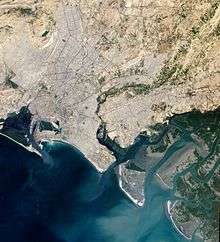
Karachi is located on the coastline of Sindh province in southern Pakistan, along a natural harbour on the Arabian Sea. Karachi is built on a coastal plains with scattered rocky outcroppings, hills and coastal marshlands. Coastal mangrove forests grow in the brackish waters around the Karachi Harbour, and farther southeast towards the expansive Indus River Delta. West of Karachi city is the Cape Monze, locally known as Ras Muari, which is an area characterised by sea cliffs, rocky sandstone promontories and undeveloped beaches.
Within the city of Karachi are two small ranges: the Khasa Hills and Mulri Hills, which lie in the northwest and act as a barrier between North Nazimabad Town and Orangi Town.[66] Karachi's hills are barren and are part of the larger Kirthar Range, and have a maximum elevation of 528 metres (1,732 feet).
Between the hills are wide coastal plains interspersed with dry river beds and water channels. Karachi has developed around the Malir River and Lyari Rivers, with the Lyari shore being the site of the settlement for Kolachi. To the west of Karachi lies the Indus River flood plain.[67]
Climate

Karachi has an arid climate (Köppen: BWh) dominated by a long "Summer Season" while moderated by oceanic influence from the Arabian Sea. The city has low annual average precipitation levels (approx. 250 mm (9.8 in) per annum), the bulk of which occurs during the July–August monsoon season. While the summers are hot and humid, cool sea breezes typically provide relief during hot summer months, though Karachi is prone to deadly heat waves,[68] though a text-message based early warning system is now in place that helped prevent any fatalities during an unusually strong heatwave in October 2017.[69] The winter climate is dry and lasts between December and February. It is dry and pleasant relative to the warm hot season, which starts in March and lasts until monsoons arrive in June. Proximity to the sea maintains humidity levels at near-constant levels year-round.
The city's highest monthly rainfall, 429.3 mm (16.90 in), occurred in July 1967.[70] The city's highest rainfall in 24 hours occurred on 7 August 1953, when about 278.1 millimetres (10.95 in) of rain lashed the city, resulting in major flooding.[71] Karachi's highest recorded temperature is 48 °C (118 °F) which was recorded on 9 May 1938,[72] and the lowest is 0 °C (32 °F) recorded on 21 January 1934.[70]
| Climate data for Karachi | |||||||||||||
|---|---|---|---|---|---|---|---|---|---|---|---|---|---|
| Month | Jan | Feb | Mar | Apr | May | Jun | Jul | Aug | Sep | Oct | Nov | Dec | Year |
| Record high °C (°F) | 32.8 (91) |
36.1 (97) |
41.5 (106.7) |
44.4 (111.9) |
47.8 (118) |
47.0 (116.6) |
42.2 (108) |
41.7 (107.1) |
42.8 (109) |
43.3 (109.9) |
38.5 (101.3) |
34.5 (94.1) |
47.8 (118) |
| Average high °C (°F) | 25.8 (78.4) |
27.7 (81.9) |
31.5 (88.7) |
34.3 (93.7) |
35.2 (95.4) |
34.8 (94.6) |
33.1 (91.6) |
31.7 (89.1) |
32.6 (90.7) |
34.7 (94.5) |
31.9 (89.4) |
27.4 (81.3) |
31.7 (89.1) |
| Daily mean °C (°F) | 18.1 (64.6) |
20.2 (68.4) |
24.5 (76.1) |
28.3 (82.9) |
30.5 (86.9) |
31.4 (88.5) |
30.3 (86.5) |
28.9 (84) |
28.9 (84) |
27.9 (82.2) |
23.9 (75) |
19.5 (67.1) |
26.0 (78.8) |
| Average low °C (°F) | 10.4 (50.7) |
12.7 (54.9) |
17.6 (63.7) |
22.3 (72.1) |
25.9 (78.6) |
27.9 (82.2) |
27.4 (81.3) |
26.1 (79) |
25.2 (77.4) |
21.0 (69.8) |
15.9 (60.6) |
11.6 (52.9) |
20.3 (68.5) |
| Record low °C (°F) | 0.0 (32) |
3.3 (37.9) |
7.0 (44.6) |
12.2 (54) |
17.7 (63.9) |
22.1 (71.8) |
22.2 (72) |
20.0 (68) |
18.0 (64.4) |
10.0 (50) |
6.1 (43) |
1.3 (34.3) |
0.0 (32) |
| Average rainfall mm (inches) | 6.0 (0.236) |
9.8 (0.386) |
11.7 (0.461) |
4.4 (0.173) |
0.0 (0) |
5.5 (0.217) |
85.5 (3.366) |
67.4 (2.654) |
19.9 (0.783) |
1.0 (0.039) |
1.8 (0.071) |
4.4 (0.173) |
217.4 (8.559) |
| Mean monthly sunshine hours | 270.7 | 249.4 | 271.6 | 277.4 | 299.1 | 231.8 | 155.0 | 147.7 | 218.8 | 283.5 | 273.3 | 272.0 | 2,950.3 |
| Source #1: NOAA[73] | |||||||||||||
| Source #2: PMD (extremes)[74] | |||||||||||||
Cityscape

The city first developed around the Karachi Harbour, and owes much of its growth to its role as a seaport at the end of the 18th century,[75] contrasted with Pakistan's millennia-old cities such as Lahore, Multan, and Peshawar. Karachi's Mithadar neighbourhood represents the extent of Kolachi prior to British rule.
British Karachi was divided between the "New Town" and the "Old Town," with British investments focused primarily in the New Town.[53] The Old Town was a largely unplanned neighbourhood which housed most of the city's indigenous residents, and had no access to sewerage systems, electricity, and water.[53] The New Town was subdivided into residential, commercial, and military areas.[53] Given the strategic value of the city, the British developed the Karachi Cantonment as a military garrison in the New Town to aid the British war effort in the First Anglo-Afghan War.[53]

The city's development was largely confined to the area north of the Chinna Creek prior to independence, although the seaside area of Clifton was also developed as a posh locale under the British, and its large bungalows and estates remain some of the city's most desirable properties. The aforementioned historic areas form the oldest portions of Karachi, and contain its most important monuments and government buildings, with the I. I. Chundrigar Road being home to most of Pakistan's banks, including the Habib Bank Plaza which was Pakistan's tallest building from 1963 until the early 2000s.[2]
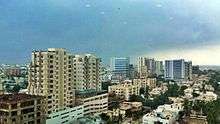
Situated on a coastal plain northwest of Karachi's historic core lies the sprawling district of Orangi Town. North of the historic core is the largely middle-class district of Nazimabad, and upper-middle class North Nazimabad, which were developed in the 1950s. To the east of the historic core is the area known as Defence – an expansive upscale suburb developed and administered by the Pakistan Army. Karachi's coastal plains along the Arabian Sea south of Clifton were also developed much later as part of the greater Defence Housing Authority project.
Karachi's city limits also include several islands, including Baba and Bhit Islands, Oyster Rocks, and Manora, a former island which is now connected to the mainland by a thin 12 kilometre long shoal known as Sandspit. The city has been described as one divided into sections for those able to afford to live in planned localities with access to urban amenities, and those who live in unplanned communities with inadequate access to such services.[76] Up to 60% of Karachi's residents live in such unplanned communities.[76]
Economy
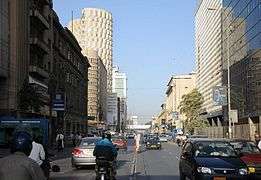
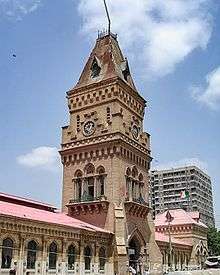
Karachi is Pakistan's financial and commercial capital.[77] Since Pakistan's independence, Karachi has been the centre of the nation's economy, and remain's Pakistan's largest urban economy despite the economic stagnation caused by sociopolitical unrest during the late 1980s and 1990s. The city forms the centre of an economic corridor stretching from Karachi to nearby Hyderabad, and Thatta.[78]
With an estimated GDP of $113 billion as of 2014,[34] Karachi contributes the bulk of Sindh's gross domestic product.[79][80][81][82] and accounts for approximately 20% of the total GDP of Pakistan.[36][37] The city has a large informal economy which is not typically reflected in GDP estimates.[83] The informal economy may constitute up to 36% of Pakistan's total economy, versus 22% of India's economy, and 13% of the Chinese economy.[84] The informal sector employs up to 70% of the city's workforce.[40] Although the city's competitiveness has declined relative to other Pakistani cities.[78] a crackdown operation against criminals initiated in 2013 by the Pakistan Rangers,[44] resulted in dramatically low crime rates[45] triggering sharp increases in real-estate prices in 2015.[46]
Today along with Pakistan's continued economic expansion Karachi is now ranked third in the world for consumer expenditure growth with its market anticipated to increase by 6.6% in real terms in 2018[85] It is also ranked among the top cities in the world by anticipated increase of number of households (1.3 million households) with annual income above $20,000 dollars measured at PPP exchange rates by year 2025.[86]
Finance and banking
Most of Pakistan's public and private banks are headquartered on Karachi's I. I. Chundrigar Road, which is known as "Pakistan's Wall Street",[2] with a large percentage of the cashflow in the Pakistani economy taking place on I. I. Chundrigar Road. Most major foreign multinational corporations operating in Pakistan have their headquarters in Karachi. Karachi is also home to the Pakistan Stock Exchange, which was rated as Asia's best performing stock market in 2015 on the heels of Pakistan's upgrade to emerging-market status by MSCI.[87]
Media and technology
Karachi has been the pioneer in cable networking in Pakistan with the most sophisticated of the cable networks of any city of Pakistan,[88] and has seen an expansion of information and communications technology and electronic media. The city has become a software outsourcing hub for Pakistan. Several independent television and radio stations are based in Karachi, including Business Plus, AAJ News, Geo TV, KTN,[89] Sindh TV,[90] CNBC Pakistan, TV ONE, Express TV,[91] ARY Digital, Indus Television Network, Samaa TV, Abb Tak, BoL TV, and Dawn News, as well as several local stations.
Industry
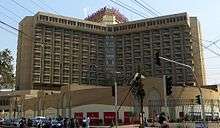
Industry contributes a large portion of Karachi's economy, with the city home to several of Pakistan's largest companies dealing in textiles, cement, steel, heavy machinery, chemicals, and food products.[92] The city is home to approximately 30 percent of Pakistan's manufacturing sector,[38] and produces approximately 42 percent of Pakistan's value added in large scale manufacturing.[93] At least 4500 industrial units form Karachi's formal industrial economy.[94] Karachi's informal manufacturing sector employs far more people than the formal sector, though proxy data suggest that the capital employed and value added from such informal enterprises is far smaller than that offormal sector enterprises.[95] An estimated 63% of the Karachi's workforce is employed in trade and manufacturing.[78]
Karachi Export Processing Zone, SITE, Korangi, Northern Bypass Industrial Zone, Bin Qasim and North Karachi serve as large industrial estates in Karachi.[96] The Karachi Expo Centre also complements Karachi's industrial economy by hosting regional and international exhibitions.[97]
| Name of estate | Location | Established | Area in acres |
|---|---|---|---|
| SITE Karachi | SITE Town | 1947 | 4700[98] |
| Korangi Industrial Area | Korangi Town | 1960 | 8500[99] |
| Landhi Industrial Area | Landhi Town | 1949 | 11000[100] |
| North Karachi Industrial Area | New Karachi Town | 1974 | 725[101] |
| Federal B Industrial Area | Gulberg Town | 1987 | [102] |
| Korangi Creek Industrial Park | Korangi Creek Cantonment | 2012 | 250[103] |
| Bin Qasim Industrial Zone | Bin Qasim Town | 1970 | 25000[104] |
| Karachi Export Processing Zone | Landhi Town | 1980[105] | 315[106] |
| Pakistan Textile City | Bin Qasim Town | 2004 | 1250[107] |
| West Wharf Industrial Area | Keamari Town | 430 | |
| SITE Super Highway Phase-I | Super Highway | 1983 | 300[108] |
| SITE Super Highway Phase-II | Super Highway | 1992 | 1000[108] |
Revenue collection
As home to Pakistan's largest ports and a large portion of its manufacturing base, Karachi contributes a large share of Pakistan's collected tax revenue. As most of Pakistan's large multinational corporations are based in Karachi, income taxes are paid in the city even though income may be generated from other parts of the country.[109] As home to the country's two largest ports, Pakistani customs officials collect the bulk of federal duty and tariffs at Karachi's ports, even if those imports are destined for one of Pakistan's other provinces.[110] Approximately 25% of Pakistan's national revenue is generated in Karachi.[36]
According to the Federal Board of Revenue's 2006–2007 year book, tax and customs units in Karachi were responsible for 46.75% of direct taxes, 33.65% of federal excise tax, and 23.38% of domestic sales tax.[111] Karachi accounts for 75.14% of customs duty and 79% of sales tax on imports,[111] and collects 53.38% of the total collections of the Federal Board of Revenue, of which 53.33% are customs duty and sales tax on imports.[111][112]
Demographics
Karachi is the most linguistically, ethnically, and religiously diverse city in Pakistan.[19] The city is a melting pot of ethno-linguistic groups from throughout Pakistan, as well as migrants from other parts of Asia. The city's inhabitants are referred to by the demonym Karachiite. The 2017 census numerated Karachi's population to be 14,910,352, having grown 2.49% per year since the 1998 census, which had listed Karachi's population at approximately 9.3 million.[113]
Population
At the end of the 19th century, Karachi had an estimated population of 105,000.[57] By the dawn of Pakistan's independence in 1947, the city had an estimated population of 400,000.[19] The city's population grew dramatically with the arrival of hundreds of thousands of Muslim refugees from the newly independent Republic of India.[23] Rapid economic growth following independence attracted further migrants from throughout Pakistan and South Asia.[24] The 2017 census numerated Karachi's population to be 14,910,352, having grown 2.49% per year since the 1998 census, which had listed Karachi's population at approximately 9.3 million.[113]
Lower than expected population figures from the census suggest that Karachi's poor infrastructure, law and order situation, and weakened economy relative to other parts of Pakistan made the city less attractive to in-migration than previously thought.[113] The figure is disputed by all the major political parties in Sindh.[114][115][116] Karachi's population grew by 59.8% since the 1998 census to 14.9 million, while Lahore city grew 75.3%[117] – though Karachi's census district had not been altered by the provincial government since 1998, while Lahore's had been expanded by Punjab's government,[117] leading to some of Karachi's growth to have occurred outside the city's census boundaries.[113] Karachi's population had grown at a rate of 3.49% between the 1981 and 1998 census, leading many analysts to estimate Karachi's 2017 population to be approximately 18 million by extrapolating a continued annual growth rate of 3.49%. Some had expected that the city's population to be between 22 and 30 million,[113] which would require an annual growth rate accelerating to between 4.6% and 6.33%.[113]
Political parties in the province have suggested the city's population has been underestimated in a deliberate attempt to undermine the political power of the city and province.[118] Senator Taj Haider from the PPP claimed he had official documents revealing the city's population to be 25.6 million in 2013,[118] while the Sindh Bureau of Statistics, part of by the PPP-led provincial administration, estimated Karachi's 2016 population to be 19.1 million.[119]
Template:Karachi historical population
Ethnicity
The oldest portions of modern Karachi reflect the ethnic composition of the first settlement, with Balochis and Sindhis continuing to make up a large portion of the Lyari neighbourhood,[25] though many of the residents are relatively recent migrants. Following Partition, large numbers of Hindus migrant Pakistan for the newly-independent Dominion of India (later the Republic of India), while a larger percentage of Muslim migrant from India settled in Karachi. The city grew 150% during the ten period between 1941 and 1951 with the arrival of migrants from India,[120] who made up 57% of Karachi's population in 1951.[121] The city is now considered a melting pot of Pakistan, and is the country's most diverse city.[25] In 2011, an estimated 2.5 million foreign migrants lived in the city, mostly from Afghanistan, Bangladesh, Myanmar, and Sri Lanka.[122]
Much of Karachi's citizenry descend from Urdu-speaking migrants from North India who became known by the Arabic term for "Migrant" – Muhajir. The first Muhajirs of Karachi arrived in 1946 in the aftermath of the Great Calcutta Killings and subsequent 1946 Bihar riots.[123] The city's wealthy Hindus opposed the resettlement of refugees near their homes, and so many refugees were accommodated in the older and more congested parts of Karachi.[124] The city witnessed a large influx of Muhajirs following Partition, who were drawn to the port city and newly designated federal capital for its white-collar job opportunities.[125] Muhajirs continued to migrate to Pakistan throughout the 1950s and early 1960s,[126] with Karachi remaining the primary destination of Indian Muslim migrants throughout those decades.[58] The Muhajir Urdu-speaking community in the 2017 census forms slightly less than 45% of the city's population.[117] Muhajirs form the bulk of Karachi's middle class.[25] Muhajirs are regarded as the city's most secular community, while other minorities such as Christians and Hindus increasingly regard themselves as part of the Muhajir community.[25]
Karachi is home to a wide array of non-Urdu speaking Muslim peoples from what is now the Republic of India. The city has a sizable community of Gujarati, Marathi, Konkani-speaking refugees.[25] Karachi is also home to a several-thousand member strong community of Malabari Muslims from Kerala in South India.[127] These ethno-linguistic groups are being assimilated in the Urdu-speaking community.[128]
During the period of rapid economic growth in the 1960s, large numbers Pashtuns from the NWFP migrated to Karachi with Afghan Pashtun refugees settling in Karachi during the 80's.[129][130][131][132][133] By some estimates, Karachi is home to the world's largest urban Pashtun population,[134] with more Pashtun citizens than the FATA.[2][134][134] While generally considered to be one of Karachi's most conservative communities, Pashtuns in Karachi generally vote for the secular Awami National Party rather than religious parties.[2] Pashtuns from Afghanistan are regarded as the most conservative community.[2] Pashtuns from Pakistan's Swat Valley, in contrast, are generally seen as more liberal in social outlook.[2] The Pashtun community forms the bulk of manual labourers and transporters.[135]
Migrants from Punjab began settling in Karachi in large numbers in the 1960s, and now make up an estimated 14% of Karachi's population.[2] The community forms the bulk of the city's police force,[2] and also form a large portion of Karachi's entrepreneurial classes and direct a larger portion of Karachi's service-sector economy.[2] The bulk of Karachi's Christian community, which makes up 2.5% of the city's population, is Punjabi.[136]
Despite being the capital of Sindh province, only 6–8% of the city is Sindhi.[2] Sindhis form much of the municipal and provincial bureaucracy.[2] 4% of Karachi's population speaks Balochi as its mother tongue, though most Baloch speakers are of Sheedi heritage – a community that traces its roots to Africa.[2]
Following the Indo-Pakistani War of 1971 and independence of Bangladesh, thousands of Urdu-speaking Biharis arrived in the city, preferring to remain Pakistani rather than live in the newly-independent country. Large numbers of Bengalis also migrated from Bangladesh to Karachi during periods of economic growth in the 1980s and 1990s. Karachi is now home to an estimated 2.5 to 3 million ethnic Bengalis living in Pakistan.[31][32] Rohingya refugees from Myanmar, who speak a dialect of Bengali and are sometimes regarded as Bengalis, also live in the city. Karachi is home to an estimated 400,000 Rohingya residents.[137][138] Large scale Rohingya migration to Karachi made Karachi one of the largest population centres of Rohingyas in the world outside of Myanmar.[139]
Central Asian migrants from Uzbekistan and Kyrghyzstan have also settled in the city.[140] Domestic workers from the Philippines are employed in Karachi's posh locales, while many of the city's teachers hail from Sri Lanka.[140] Expatriates from China began migrating to Karachi in the 1940s, to work as dentists, chefs and shoemakers, while many of their decedents continue to live in Pakistan.[140][141] The city is also home to a small number of British and American expatriates.[142]
During World War II, about 3,000 Polish refugees from the Soviet Union, with some Polish families who chose to remain in the city after Partition.[143][144] Post-Partition Karachi also once had a sizable refugee community from post-revolutionary Iran.[140]
Religion
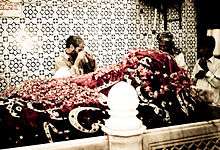

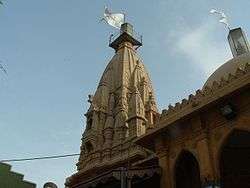
Karachi is one of Pakistan's most religiously diverse cities.[19] Karachiites adhere to numerous sects and sub-sects of Islam, as well as Protestant Christianity, and community of Goan Catholics. The city also is home to large numbers of Hindus, and a small community of Zoroastrians.
Prior to Pakistan's independence in 1947, the population of the city was estimated to be 50% Muslim, 40% Hindu, with the remaining 10% primarily Christians (both British and native), with a small numbers of Jews. Following the independence of Pakistan, much of Karachi's Sindhi Hindu population left for India while Muslim refugees from India in turn settled in the city. The city continued to attract migrants from throughout Pakistan, who were overwhelmingly Muslim, and city's population nearly doubled again in the 1950s.[120] As a result of continued migration, over 96.5% of the city currently is estimated to be Muslim.[2]
Karachi is overwhelmingly Muslim,[2] though the city is one of Pakistan's most secular cities.[25][26][27] Approximately 65% of Karachi's Muslims are Sunnis, while 35% are Shi'ites.[150][151][152] Sunnis primarily follow the Hanafi school of jurisprudence, with Sufism influencing religious practices by encouraging reverence for Sufi saints such as Abdullah Shah Ghazi and Mewa Shah. Shi'ites are predominantly Twelver, with a significant Ismaili minority which is further subdivided into Nizaris, Mustaalis, Dawoodi Bohras, and Sulaymanis.
Approximately 2.5% of Karachi's population is Christian.[145][146][147] The city's Christian community is primarily composed of Punjabi Christians,[136] who converted from Sikhism to Christianity during the British Raj.[153] Karachi has a community of Goan Catholics who are typically better-educated and more affluent than their Punjabi co-religionists.[154] The Goan community dates from 1820 and has a population estimated to be 12,000–15,000 strong.[155]
While most of the city's Hindu population left en masse for India following Pakistan's independence, Karachi still has a large Hindu community with an estimated population of 250,000 based on 2013 data.[156] Karachi's affluent and influential Parsis have lived in the region in the 12th century, though the modern community dates from the mid 19th century when they served as military contractors and commissariat agents to the British.[157] Further waves of Parsi immigrants from Persia settled in the city in the late 19th century.[158] The population of Parsis in Karachi and throughout South Asia is in continuous decline due to low birth-rates and migration to Western countries.[159]
Language
Karachi has the largest number of Urdu speakers in Pakistan.[88] As per the 1998 census, the linguistic breakdown of Karachi Division is:
| Rank | Language | 1998 census[160] | Speakers | 1981 census[161] | Speakers |
|---|---|---|---|---|---|
| 1 | Urdu | 48.52% | 4,497,747 | 54.34% | 2,830,098 |
| 2 | Punjabi | 13.94% | 1,292,335 | 13.64% | 710,389 |
| 3 | Pashto | 11.42% | 1,058,650 | 08.71% | 453,628 |
| 4 | Sindhi | 07.22% | 669,340 | 06.29% | 327,591 |
| 5 | Balochi | 04.34% | 402,386 | 04.39% | 228,636 |
| 6 | Saraiki | 02.11% | 195,681 | 00.35% | 18,228 |
| 7 | Others | 12.44% | 1,153,126 | 12.27% | 639,560 |
| All | 100% | 9,269,265 | 100% | 5,208,132 |
The category of "others" includes Gujarati, Dawoodi Bohra, Memon, Marwari, Dari, Brahui, Makrani, Hazara, Khowar, Gilgiti, Burushaski, Balti, Arabic, Farsi and Bengali.[162]
Transportation
Road
Karachi is served by a road network estimated to be approximately 9,500 kilometres (5,900 miles) in length,[163] serving approximately 3.1 million vehicles per day.[164]
Karachi is served by three "Signal-Free Corridors" which are designed as urban express roads to permit traffic to transverse large distances without the need to stop at intersections and stop lights.[164] The first opened in 2007 and connects Shah Faisal Town in eastern Karachi to the industrial-estates in SITE Town 10.5 kilometres (6.5 miles) away. The second corridor connects Surjani Town with Shahrah-e-Faisal over a 19 kilometre span, while the third stretch 28 kilometres (17 miles) and connects Karachi's urban centre to the Gulistan-e-Johar suburb. A fourth corridor is currently under construction that will link Karachi's centre to Karachi's Malir Town.
Karachi will be the terminus of the under construction M-9 motorway, which will connect Karachi to Hyderabad. The road is being constructed as part of a much larger motorway network under construction as part of the expansive China Pakistan Economic Corridor. From Hyderabad, motorways have been built, or are being constructed, to provide high-speed road access to the northern Pakistani cities of Peshawar and Mansehra 1,100 kilometres (680 miles) to the north of Karachi.
Karachi is also the terminus of the N-5 National Highway which connects the city to the historic medieval capital of Sindh, Thatta. It offers further connections to northern Pakistan and the Afghan border near Torkham, as well as the N-25 National Highway which connects the port city to the Afghan border near Quetta.
Within the city of Karachi, the Lyari Expressway is a controlled-access highway along the Lyari River in Karachi, Sindh, Pakistan. As of 8 February 2018 Lyari Expressway's north-bound and south-bound sections are both complete and open for traffic.[165] This toll highway is designed to relieve congestion in the city of Karachi. To the north of Karachi lies the Karachi Northern Bypass (M10), which starts near the junction of the M9. It then continues north for a few kilometres before turning west, where it intersects the N25.
Rail
Karachi is linked by rail to the rest of the country by Pakistan Railways. The Karachi City Station and Karachi Cantonment Railway Station are the city's two major railway stations.[2] The city has an international rail link, the Thar Express which links Karachi Cantonment Station with Bhagat Ki Kothi station in Jodhpur, India.[166]
The railway system also handles freight linking Karachi port to destinations up-country in northern Pakistan.[167] The city is the terminus for the Main Line-1 Railway which connects Karachi to Peshawar. Pakistan's rail network, including the Main Line-1 Railway is being upgraded as part of the China Pakistan Economic Corridor, allowing trains to depart Karachi and travel on Pakistani railways at an average speed of 160 kilometres per hour (99 miles per hour) versus the average 60 to 105 kilometres per hour (37 to 65 miles per hour) speed currently possible on existing track.[168]
Public transport

Karachi's public transport infrastructure is inadequate and constrained by low levels of investment.[169] Karachi is not currently served by any municipal public transit, and is instead serviced primarily by the private and informal sector.[170]
Metrobus
The Pakistani Government is developing the Karachi Metrobus project, which is a multi-line 112.9 kilometres (70.2 miles) bus rapid transit system currently under construction.[171] The Metrobus project was inaugurated by then-Prime Minister Nawaz Sharif on 25 February 2016. Sharif stated that the "project will be more beautiful than Lahore Metro Bus."[172] The projects initial launch date was February 2017, but due to the slow pace of work, it is not yet operational.
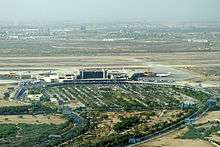
Karachi Circular Railway
Karachi was once served by numerous trams and the Karachi Circular Railway, although both systems are no longer in operation. While the Japanese Government has expressed willingness to help fund the refurbishment of the Karachi Circular Railway,[173] the project has not been finalized.
Air
Karachi's Jinnah International Airport is the busiest airport of Pakistan with a total of 6.2 million passengers in 2015.[174] The current terminal structure was built in 1992, and is divided into international and domestic sections. Karachi's airport serves as a hub for the flag carrier, Pakistan International Airlines (PIA), as well as for Air Indus, Shaheen Air, and airblue. The airport offers non-stop flights to destinations throughout East Asia, South Asia, Southeast Asia, the Persian Gulf States, Europe and North America.[175][176]
Sea
The largest shipping ports in Pakistan are the Port of Karachi and the nearby Port Qasim, the former being the oldest port of Pakistan. Port Qasim is located 35 kilometres (22 miles) east of the Port of Karachi on the Indus River estuary. These ports handle 95% of Pakistan's trade cargo to and from foreign ports. These seaports have modern facilities which include bulk handling, containers and oil terminals.[177]
Civic administration
_Head_Office_at_M.A_Jinnah_Road_-_Photo_By_Aliraza_Khatri.jpg)
Historical background
In response to a cholera epidemic in 1846, the Karachi Conservancy Board was organized by British administrators.[178][179] The board became the Karachi Municipal Commission in 1852, and the Karachi Municipal Committee the following year.[178] The City of Karachi Municipal Act of 1933 transformed the city administration into the Karachi Municipal Corporation with a mayor, a deputy mayor and 57 councillors.[178] In 1976, the body became the Karachi Metropolitan Corporation.[178]
During the 1900s, Karachi saw its major beautification project under the mayoralty of Harchandrai Vishandas. New roads, parks, residential, and recreational areas were developed as part of this project. In 1948, the Federal Capital Territory of Pakistan was created, comprising approximately 2,103 km2 (812 sq mi) of Karachi and surrounding areas, but this was merged into the province of West Pakistan in 1961.[180] In 1996, the metropolitan area was divided into five districts, each with its own municipal corporation.[178]
Union councils (2001–11)
In 2001, five districts of Karachi were merged to form the city district of Karachi, with a three-tier structure. The two most local tiers are composed of 18 towns, and 178 union councils.[181] Each tier focused on elected councils with some common members to provide "vertical linkage" within the federation.[182]
Naimatullah Khan was the first Nazim of Karachi during the Union Council period, while Shafiq-Ur-Rehman Paracha was the first district co-ordination officer of Karachi. Syed Mustafa Kamal was elected City Nazim of Karachi to succeed Naimatullah Khan in 2005 elections, and Nasreen Jalil was elected as the City Naib Nazim.
Each Union Council had thirteen members elected from specified electorates: four men and two women elected directly by the general population; two men and two women elected by peasants and workers; one member for minority communities; two members are elected jointly as the Union Mayor (Nazim) and Deputy Union Mayor (Naib Nazim).[183] Each council included up to three council secretaries and a number of other civil servants. The Union Council system was dismantled in 2011.
District municipal corporations
In 2011, city district government of Karachi was reverted its original constituent units known as District Municipal Corporations (DMC). The five original DMCs are: Karachi East, Karachi West, Karachi Central, Karachi South and Malir. In November 2013, a sixth DMC, "Korangi" was carved out from District East.[184][185][186][187][188]
The current city administrator is Muhammad Hussain Syed[189] and Municipal Commissioner of Karachi is Matanat Ali Khan.[190] The position of Commissioner of Karachi was created and Shoaib Ahmad Siddiqui was appointed as the Commissioner of Karachi.[191] There are six military cantonments, which are administered by the Pakistani Army, and are some of Karachi's most upscale neighbourhoods.
|
Municipal services
Water
76% of Karachi households have access to piped water as of 2015,[192] with private water tankers supplying much of the water required in informal settlements.[78] 18% of residents in a 2015 survey rated their water supply as "bad," or "very bad," while 44% expressed concern at the stability of water supply.[192] By 2015, an estimated 30,000 people were dying due to water-borne diseases annually.[193]
The K-IV water project is under development at a cost of $876 million, that will provide 650 million gallons daily of potable water to the city, with the first phase expected to supply 260 million gallons by June 2018.[194][195]
Sanitation
98% of Karachi's households are connected to the city's underground public sewerage system,[192] largely operated by the Karachi Water and Sewerage Board. Households in Orangi Town self-organized in order to set-up their own sewerage system under the Orangi Pilot Project,[196] a community service organization founded in 1980. 90% of Orangi streets are now connected to a sewer system built by local residents under the Orangi Pilot Project.[196] Residents of individual streets bear the cost of sewerage pipes, and provide volunteer labour to lay the pipe.[196] Residents also maintain the sewer pipes,[196] while the city municipal administration has built several primary and secondary pipes for the network.[196] As a result of OPP, 96% of Orangi residents have access to a latrine.[196]
72% reported in 2015 that Karachi's drainage system overflows or backs up,[192] – the highest percentage of all major Pakistani cities.[192] Parts of the city's drainage system overflows on average 2–7 times per month, flooding some city streets.[192]
Karachi has the highest percentage of residents in Pakistan who report that their streets are never cleaned – 42% of residents in Karachi report their streets are never cleaned, compared to 10% of residents in Lahore.[192] Only 17% of Karachi residents reporting daily street cleaning, compared to 45% in Lahore.[192] 69% of Karachi residents rely on private garbage collection services,[192] with only 15% relying on municipal garbage collection services.[192] 57% of Karachi residents in a 2015 survey reported that the state of their neighbourhood's cleanliness was either "bad" or "very bad".[192] compared to 35% in Lahore,[192] and 16% in Multan.[192]
Education
Primary and secondary
Karachi's primary education system is divided into five levels: primary (grades one through five); middle (grades six through eight); high (grades nine and ten, leading to the Secondary School Certificate); intermediate (grades eleven and twelve, leading to a Higher Secondary School Certificate); and university programs leading to graduate and advanced degrees. Karachi has both public and private educational institutions. Most educational institutions are gender-based, from primary to university level.
Several of Karachi's schools, such as St Patrick's High School, and St Paul's English High School, are operated by Christian churches, and among Pakistan's most prestigious schools.
Higher

Karachi is home to several major public universities. Karachi's first public university's date from the British colonial era. The Sindh Madressatul Islam founded in 1885, was granted university status in 2012. Establishment of the Sindh Madressatul Islam was followed by the establishment of the D. J. Sindh Government Science College in 1887, and the institution was granted university status in 2014. The Nadirshaw Edulji Dinshaw University of Engineering and Technology (NED), was founded in 1921, and is Pakistan's oldest institution of higher learning. The Dow University of Health Sciences was established in 1945, and is now one of Pakistan's top medical research institutions.
The University of Karachi, founded in 1951, is Pakistan's largest university with a student population of 24,000. The Institute of Business Administration (IBA), founded in 1955, is the oldest business school outside of North America and Europe, and was set up with technical support from the Wharton School and the University of Southern California. The Dawood University of Engineering and Technology, which opened in 1962, offers degree programmes in petroleum, gas, chemical, and industrial engineering. The Pakistan Navy Engineering College (PNEC), operated by the Pakistan Navy, is associated with the National University of Sciences and Technology (NUST) in Islamabad.
Karachi is also home to numerous private universities. The Aga Khan University, founded in 1983, is Karachi's oldest private educational institution, and is one of Pakistan's most prestigious medical schools. The Indus Valley School of Art and Architecture was founded in 1989, and offers degree programmes in arts and architectural fields. Hamdard University is the largest private university in Pakistan with faculties including Eastern Medicine, Medical, Engineering, Pharmacy, and Law. The National University of Computer and Emerging Sciences (NUCES-FAST), one of Pakistan's top universities in computer education, operates two campuses in Karachi. Sir Syed University of Engineering and Technology (SSUET) offers degree programmes in biomedical, electronics, telecom and computer engineering. Karachi Institute of Economics & Technology (KIET) has two campuses in Karachi. The Shaheed Zulfiqar Ali Bhutto Institute of Science and Technology (SZABIST), founded in 1995 by former Prime Minister Benazir Bhutto, operates a campus in Karachi.
- Iqra University
- Habib University
 Habib University is a liberal arts college in Karachi.
Habib University is a liberal arts college in Karachi. - Dow University
- Jinnah Medical and Dental College
- Jinnah Sindh Medical University
- Pakistan Air Force – Karachi Institute of Economics and Technology
- United Medical and Dental College
- Liaquat National Medical College
- Institute of Cost & Management Accountants of Pakistan (ICMAP)
Healthcare
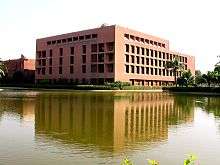
Karachi is a centre of research in biomedicine with at least 30 public hospitals, 80 registered private hospitals and 12 recognized medical colleges,[197] including the Indus Hospital, Karachi Institute of Heart Diseases,[198] National Institute of Cardiovascular Diseases,[199] Civil Hospital,[200] Combined Military Hospital,[201] PNS Rahat,[202] PNS Shifa,[203] Aga Khan University Hospital, Liaquat National Hospital, Jinnah Postgraduate Medical Centre,[204] Holy Family Hospital[205] and Ziauddin Hospital. In 1995, Ziauddin Hospital was the site of Pakistan's first bone marrow transplant.[206]
Karachi municipal authorities in October 2017 launched a new early warning system that alerted city residents to a forecasted heatwave. Previous heatwaves had routinely claimed lives in the city, but implementation of the warning system was credited for no reported heat-related fatalities.[69]
Art and culture
Museums and galleries
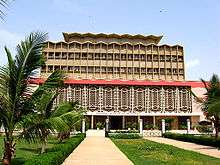
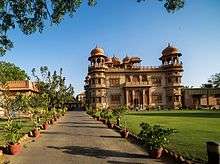
Karachi is home to several of Pakistan's most important museums. The National Museum of Pakistan and Mohatta Palace display artwork, while the city also has several private art galleries.[207] The city is also home to the Pakistan Airforce Museum and Pakistan Maritime Museum are also located in the city. Wazir Mansion, the birthplace of Pakistan's founder Muhammad Ali Jinnah has also been preserved as a museum open to the public.
Theatre and cinema
Karachi is home to some of Pakistan's important cultural institutions. The National Academy of Performing Arts,[208] located in the former Hindu Gymkhana, offers diploma courses in performing arts that includes classical music and contemporary theatre. Karachi is home to groups such as Thespianz Theater, a professional youth-based, non-profit performing arts group, which works on theatre and arts activities in Pakistan.[209][210]
Though Lahore is considered to be home of Pakistan's film industry, Karachi is home to Kara Film Festival annually showcases independent Pakistani and international films and documentaries.[211]
Music
The All Pakistan Music Conference, linked to the 45-year-old similar institution in Lahore, has been holding its annual music festival since its inception in 2004.[212] The National Arts Council (Koocha-e-Saqafat) has musical performances and mushaira.
Tourist attractions

Karachi is a tourist destination for domestic and international tourists. Tourist attractions near Karachi city include:
Museums: Museums located in Karachi include the National Museum of Pakistan, Pakistan Air Force Museum, and Pakistan Maritime Museum.
Parks: Parks located in Karachi include Bagh Ibne Qasim, Boat Basin Park, Mazar-e-Quaid, Karachi Zoo, Hill Park, Safari Park, Bagh-e-Jinnah, PAF Museum Park and Maritime Museum Park.
Social issues
Crime
Sometimes stated to be amongst the world's most dangerous cities,[213] the extent of violent crime in Karachi is not as significant in magnitude as compared to other cities.[214] According to the Numbeo Crime Index 2014, Karachi was the 6th most dangerous city in the world. By the middle of 2016, Karachi's rank had dropped to 31 following the launch of anti-crime operations.[215] By 2018, Karachi's ranking has dropped to 50.[216]
The city's large population results in high numbers of homicides with a moderate homicide rate.[214] Karachi's homicide rates are lower than many Latin American cities,[214] and in 2015 was 12.5 per 100,000[217] – lower than the homicide rate of several American cities such as New Orleans and St. Louis.[218] The homicide rates in some Latin American cities such as Caracas, Venezuela and Acapulco, Mexico are in excess of 100 per 100,000 residents,[218] many times greater than Karachi's homicide rate. In 2016, the number of murders in Karachi had dropped to 471, which had dropped further to 381 in 2017.[219]
In the late 1980s and early 1990s, Karachi was rocked by political conflict while crime rates drastically increased with the arrival of weaponry from the War in Afghanistan.[43] Several of Karachi's criminal mafias became powerful during a period in the 1990s described as "the rule of the mafias."[220] Major mafias active in the city included land mafia, water tanker mafia, transport mafia and a sand and gravel mafia.[221][220][222][223] Karachi's highest death rates occurred in the mid 1990s when Karachi was much smaller. In 1995, 1,742 killings were recorded,[224] when the city had over 5 million fewer residents.[225]
Karachi Operation
Karachi had become widely known for its high rates of violent crime, but rates sharply decreased following a controversial crackdown operation against criminals, the MQM party, and Islamist militants initiated in 2013 by the Pakistan Rangers.[44] In 2015, 1,040 Karachiites were killed in either acts of terror or crime – an almost 50% decrease from the 2,023 deaths in 2014,[226] and an almost 70% decrease from the 3,251 deaths recorded in 2013 – the highest ever recorded number in Karachi history.[227] Despite a sharp decrease in violent crime, street crime remains high.[228]
With 650 homicides in 2015, Karachi's homicide rate decreased by 75% compared to 2013.[45] In 2017, the number of homicides had dropped further to 381.[219] Extortion crimes decreased by 80% between 2013 and 2015, while kidnappings decreased by 90% during the same period.[45] By 2016, the city registered a total of 21 cases of kidnap for ransom.[229] Terrorist incidents dropped by 98% between 2012 and 2017, according to Pakistan's Interior Ministry.[230] As a result of the Karachi's improved security environment, real-estate prices in Karachi rose sharply in 2015,[46] with a rise in business for upmarket restaurants and cafés.[231]
Ethnic conflict
Insufficient affordable housing infrastructure to absorb growth has resulted in the city's diverse migrant populations being largely confined to ethnically homogenous neighbourhoods.[78] The 1970s saw major labour struggles in Karachi's industrial estates. Violence originated in the city's university campuses, and spread into the city.[232] Conflict was especially sharp between MQM party and ethnic Sindhis, Pashtuns, and Punjabis. The party and its vast network of supporters were targeted by Pakistani security forces as part of the controversial Operation Clean-up in 1992, as part of an effort to restore peace in the city that lasted until 1994.[64]
Poor infrastructure
Urban planning and service delivery have not kept pace with Karachi's growth, resulting in the city's low ranking on livability rankings.[78] The city has no cohesive transportation policy, and no official public transit system, though up to 1,000 new cars are added daily to the city's congested streets.[78]
Unable to provide housing to large numbers of refugees shortly after independence, Karachi's authorities first issued "slips" to refugees beginning in 1950 – which allowed refugees to settle on any vacant land.[196] Such informal settlements are known as katchi abadis, and now approximately half the city's residents live in these unplanned communities.[78]
Architecture
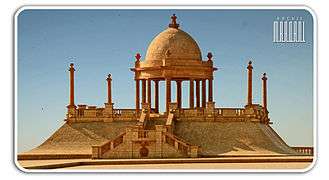
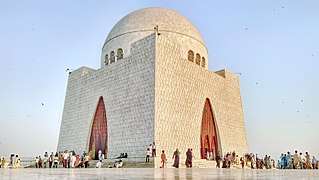
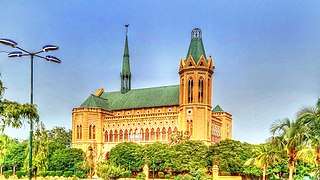
 Khaliq Deena Hall
Khaliq Deena Hall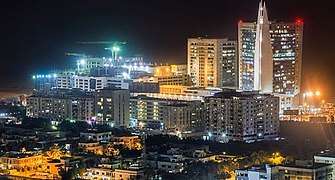 Modern high-rises in Clifton
Modern high-rises in Clifton
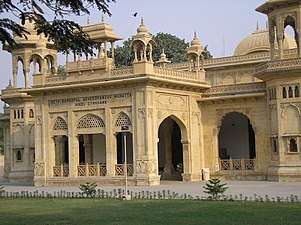
Karachi has a collection of buildings and structures of varied architectural styles. The downtown districts of Saddar and Clifton contain early 20th-century architecture, ranging in style from the neo-classical KPT building to the Sindh High Court Building. Karachi acquired its first neo-Gothic or Indo-Gothic buildings when Frere Hall, Empress Market and St. Patrick's Cathedral were completed. The Mock Tudor architectural style was introduced in the Karachi Gymkhana and the Boat Club. Neo-Renaissance architecture was popular in the 19th century and was the architectural style for St. Joseph's Convent (1870) and the Sind Club (1883).[233] The classical style made a comeback in the late 19th century, as seen in Lady Dufferin Hospital (1898)[234] and the Cantt. Railway Station. While Italianate buildings remained popular, an eclectic blend termed Indo-Saracenic or Anglo-Mughal began to emerge in some locations.[235]
The local mercantile community began acquiring impressive structures. Zaibunnisa Street in the Saddar area (known as Elphinstone Street in British days) is an example where the mercantile groups adopted the Italianate and Indo-Saracenic style to demonstrate their familiarity with Western culture and their own. The Hindu Gymkhana (1925) and Mohatta Palace are examples of Mughal revival buildings.[236] The Sindh Wildlife Conservation Building, located in Saddar, served as a Freemasonic Lodge until it was taken over by the government. There are talks of it being taken away from this custody and being renovated and the Lodge being preserved with its original woodwork and ornate wooden staircase.[237]
Indus Valley School of Art and Architecture is one of the prime examples of Architectural conservation and restoration where an entire Nusserwanjee building from Kharadar area of Karachi has been relocated to Clifton for adaptive reuse in an art school. The procedure involved the careful removal of each piece of timber and stone, stacked temporarily, loaded on the trucks for transportation to the Clifton site, unloaded and re-arranged according to a given layout, stone by stone, piece by piece, and completed within three months.[238]
Architecturally distinctive, even eccentric, buildings have sprung up throughout Karachi. Notable example of contemporary architecture include the Pakistan State Oil Headquarters building. The city has examples of modern Islamic architecture, including the Aga Khan University hospital, Masjid e Tooba, Faran Mosque, Bait-ul Mukarram Mosque, Quaid's Mausoleum, and the Textile Institute of Pakistan. One of the unique cultural elements of Karachi is that the residences, which are two- or three-story townhouses, are built with the front yard protected by a high brick wall. I. I. Chundrigar Road features a range of extremely tall buildings. The most prominent examples include the Habib Bank Plaza, PRC Towers and the MCB Tower which is the tallest skyscraper in Pakistan.[239]
Sports
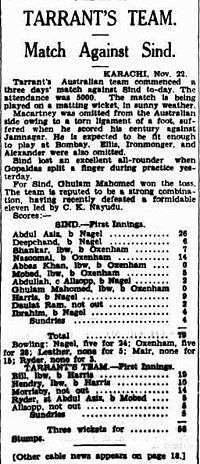
When it comes to sports Karachi has a distinction, because some sources cite that it was in 1877 at Karachi in (British) India, where the first attempt was made to form a set of rules of badminton[240] and likely place is said to Frere Hall.
Cricket's history in Pakistan predates the creation of the country in 1947. The first ever international cricket match in Karachi was held on 22 November 1935 between Sindh and Australian cricket teams. The match was seen by 5,000 Karachiites.[241] Karachi is also the place that innovated tape ball, a safer and more affordable alternative to cricket.[242]
The inaugural first-class match at the National Stadium was played between Pakistan and India on 26 February 1955 and since then Pakistani national cricket team has won 20 of the 41 Test matches played at the National Stadium.[243] The first One Day International at the National Stadium was against the West Indies on 21 November 1980, with the match going to the last ball.
The national team has been less successful in such limited-overs matches at the ground, including a five-year stint between 1996 and 2001, when they failed to win any matches. The city has been host to a number of domestic cricket teams including Karachi,[244] Karachi Blues,[245] Karachi Greens,[246] and Karachi Whites.[247] The National Stadium hosted two group matches (Pakistan v. South Africa on 29 February and Pakistan v. England on 3 March), and a quarter-final match (South Africa v. West Indies on 11 March) during the 1996 Cricket World Cup.[248]
The city has hosted seven editions of the National Games of Pakistan, most recently in 2007.[249]
In 2005, the city hosted the SAFF Championship at this ground, as well as the Geo Super Football League 2007, which attracted capacity crowds during the games. The popularity of golf is increasing, with clubs in Karachi like Dreamworld Resort, Hotel & Golf Club, Arabian Sea Country Club, DA Country & Golf Club. The city has facilities for field hockey (the Hockey Club of Pakistan, UBL Hockey Ground), boxing (KPT Sports Complex), squash (Jahangir Khan Squash Complex), and polo. There are marinas and boating clubs. National Bank of Pakistan Sports Complex is First-class cricket venue and Multi-purpose sports facility in Karachi,
- Professional Karachi teams
| Club | League | Sport | Venue | Established |
|---|---|---|---|---|
| Karachi Kings | Pakistan Super League | Cricket | Dubai International Cricket Stadium | 2015 |
| Karachi Dolphins | National T20 League/National One-day Championship | Cricket | National Stadium | 2004 |
| Karachi Zebras | National T20 League/National One-day Championship | Cricket | National Stadium | 2004 |
| HBL FC | Pakistan Premier League | Football | Peoples Football Stadium | 1975 |
| K-Electric F.C. | Pakistan Premier League | Football | Peoples Football Stadium | 1913 |
| KPT F.C. | Pakistan Premier League | Football | KPT Football Stadium | 1887 |
| NBP F.C. | Pakistan Premier League | Football | KPT Football Stadium | N/A |
| PIA F.C. | Pakistan Premier League | Football | KPT Football Stadium | 1958 |
See also
- Cinema in Karachi
- Cuisine of Karachi
- Karachi Circular Railway
- List of Art Galleries of Karachi
- List of cemeteries in Karachi
- List of hospitals in Karachi
- List of magazines in Karachi
- List of newspapers in Karachi
- List of parks and gardens in Karachi
- List of people from Karachi
- List of streets of Karachi
- List of tallest buildings in Karachi
- List of television stations in Karachi
- Media in Karachi
- Sister cities of Karachi
- Transport in Karachi
References
- ↑ Sarina Singh 2008, p. 164.
- 1 2 3 4 5 6 7 8 9 10 11 12 13 14 15 16 17 18 19 20 Nadeem F. Paracha. "Visual Karachi: From Paris of Asia, to City of Lights, to Hell on Earth". Dawn. Pakistan. Retrieved 10 March 2016.
- ↑ Ghosh, Palash (22 August 2013). "Karachi, Pakistan: Troubled, Violent Metropolis Was Once Called 'Paris Of The East'". International Business Times. Retrieved 8 January 2017.
- ↑ Hunt Janin & Scott A. Mandia 2012, p. 98.
- ↑ Sind Muslim College 1965.
- ↑ "District in Karachi". Karachi Metropolitan Corporation. Retrieved 6 May 2014.
- ↑ "Government". Karachi Metropolitan Corporation. Retrieved 6 May 2014.
- ↑ "Geography & Demography". City District Government of Karachi. Retrieved 22 August 2010.
- ↑ "Ten major cities' population up by 74pc". Retrieved 21 October 2017.
- 1 2 "PROVISIONAL SUMMARY RESULTS OF 6TH POPULATION AND HOUSING CENSUS-2017". Pakistan Bureau of Statistics. Retrieved 21 October 2017.
- ↑ "Global city GDP rankings 2008–2025". PricewaterhouseCoopers. Archived from the original on 13 May 2011. Retrieved 12 February 2010.
- ↑ "Population size and growth of major cities" (PDF). Pakistan Bureau of Statistics. 1998.
- ↑ Amer, Khawaja (10 June 2013). "Population explosion: Put an embargo on industrialisation in Karachi". The Express Tribune. Retrieved 16 June 2017.
- ↑ "Population explosion: Put an embargo on industrialisation in Karachi". The Express Tribune. 6 October 2013. Retrieved 16 June 2017.
- ↑ Brinkhoff, Thomas. "The Principal Agglomerations of the World". City Population. Retrieved 8 April 2015.
- ↑ "GaWC – The World According to GaWC 2008". Lboro.ac.uk. 3 June 2009. Retrieved 14 September 2009.
- ↑ "GAWC World Cities Ranking List". Diserio.com. Retrieved 14 September 2009.
- ↑ "PIGJE". pigje.com.pk. Archived from the original on 30 September 2014. Retrieved 25 February 2016.
- 1 2 3 4 5 6 7 Inskeep, Steve (2012). Instant City: Life and Death in Karachi. Penguin Publishing Group. p. 284. ISBN 978-0-14-312216-6. Archived from the original on 30 October 2016. Retrieved 30 October 2016.
- ↑ Mahim, Maher (3 November 2013). "Karachi's Stone Age proves history didn't start with the Muslims". The Express Tribune. Retrieved 16 October 2016.
- 1 2 Gayer, Laurent (2014). Karachi: Ordered Disorder and the Struggle for City. HarperCollins Publishers. p. 368. ISBN 9789351160861. Archived from the original on 23 December 2016. Retrieved 30 October 2016.
- 1 2 3 4 Askari, Sabiah (2015). Studies on Karachi: Papers Presented at the Karachi Conference 2013. Cambridge Scholars Publishing. ISBN 978-1-4438-7744-2. Retrieved 30 October 2016.
- 1 2 "Port Qasim | About Karachi". Port Qasim Authority. Retrieved 10 February 2014.
- 1 2 Brunn, Stanley (2008). Cities of the World: World Regional Urban Development. Rowman & Littlefield. p. 647. ISBN 978-0-7425-5597-6. Archived from the original on 23 December 2016. Retrieved 30 October 2016.
- 1 2 3 4 5 6 7 Nadeem F. Paracha. "Visual Karachi: From Paris of Asia, to City of Lights, to Hell on Earth". Dawn. Retrieved 8 March 2016.
- 1 2 Abbas, Qaswar. "Karachi: World's most dangerous city". India Today. Retrieved 24 October 2016.
Karachi, Pakistan's largest city, with a population of 1.9 crore (Mumbai has 2 crore people), is the country's most liberal and secular metropolis.
- 1 2 "Pakistani journalists face threats from Islamists". Deutsche Welle. Retrieved 24 October 2016.
This all happened in the heart of Karachi – a relatively liberal city with a population of more than 15 million
- ↑ "Populations of 150 Largest Cities in the World". worldatlas. 7 March 2016. Retrieved 2 June 2016.
- ↑ "Demographia: World Urban Areas: 12th Annual Edition: 2016:04" (PDF). demographia.com. Archived (PDF) from the original on 13 October 2016. Retrieved 30 October 2016.
- ↑ Kotkin, Joel. "The World's Fastest-Growing Megacities". Forbes.
- 1 2 "Falling back". Daily Times. Archived from the original on 5 August 2011. Retrieved 24 August 2010.
- 1 2 "Chronology for Biharis in Bangladesh". Center for International Development and Conflict Management, University of Maryland. 10 January 2007. Archived from the original on 2 June 2010. Retrieved 6 May 2010.
- ↑ Craig, Time. "Pakistan cracks down on Afghan immigrants, fearing an influx as U.S. leaves Afghanistan". The Washington Post. Retrieved 24 October 2016.
Qaim Ali Shah, the chief minister of Sindh province in southern Pakistan, said at a news conference in February that there were already more than 1 million illegal Afghan immigrants living in Karachi, a rapidly growing city of 22 million people.
- 1 2 Centre for Risk Studies at the University of Cambridge Judge Business School. "Karachi factsheet: Lloyd's City Risk Index". Lloyd's City Risk Index 2015–2025. Lloyd's. Archived from the original on 24 November 2016. Retrieved 23 November 2016.
- ↑ "The importance of Karachi – The Express Tribune". The Express Tribune. 12 October 2015. Retrieved 13 June 2016.
- 1 2 3 Asian Development Bank. "Karachi Mega-Cities Preparation Project" (PDF). Archived from the original (PDF) on 25 August 2011. Retrieved 1 January 2009.
- 1 2 The Trade & Environment Database. "The Karachi Coastline Case". Archived from the original on 25 August 2011. Retrieved 1 January 2009.
- 1 2 Pakistan and Gulf Economist. "Karachi: Step-motherly treatment". Archived from the original on 25 August 2011. Retrieved 15 October 2007.
- 1 2 Drivers of Long-Term {{subst:lc:Insecurity}} and Instability in Pakistan: Urbanization. Rand Corporation. 2014. p. 18. ISBN 978-0-8330-8750-8.
- 1 2 Hasan, Arif (April 2015). "Land contestation in Karachi and the impact on housing and urban development". Environment and Urbanization. 27 (1): 217–230. doi:10.1177/0956247814567263. PMC 4540218. PMID 26321797.
- ↑ "The Informal Economy: Fact Finding Study" (PDF). Department for Infrastructure and Economic Cooperation. Retrieved 1 December 2016.
- ↑ Gayer, Laurent (2014). Karachi: Ordered Disorder and the Struggle for the City. Oxford University Press. p. 18. ISBN 978-0-19-023806-3.
- 1 2 3 "2011 brings a violent and bloody year of ethnic conflict to Karachi, Pakistan". Public Radio International. 19 January 2012. Retrieved 16 October 2016.
- 1 2 3 4 ur-Rehman, Zia (7 November 2015). "Crime Down in Karachi, Paramilitary in Pakistan Shifts Focus". The New York Times. Retrieved 22 October 2016.
- 1 2 3 4 "Karachi property prices soar after Pakistan crime crackdown". Reuters. 29 February 2016. Retrieved 22 October 2016.
Recorded murders in Karachi fell to 650 last year, a 75 percent drop from 2013, while registered extortion was down 80 percent and kidnapping by nearly 90 percent, according to the CPLC, which collates official police data.
- 1 2 3 "Karachi property prices soar after Pakistan crime crackdown". Reuters. 29 February 2016. Retrieved 22 October 2016.
Karachi property prices jumped 23 percent last year to a record high, outpacing other large cities and the national average of 10 percent, data from property website Zameen.com showed.
- ↑ Archived 24 September 2013 at the Wayback Machine.
- ↑ The Dutch East India Company (VOC) and Diewel-Sind (Pakistan) in the 17th and 18th centuries, Floor, W. Institute of Central & West Asian Studies, University of Karachi, 1993–1994, p. 49.
- ↑ "The Dutch East India Company's shipping between the Netherlands and Asia 1595–1795". Retrieved 14 June 2015.
- ↑ Laurent Gayer 2014, pp. 42.
- ↑ Neill, John Martin Bladen (1846). Recollections of Four Years' Service in the East with H.M. Fortieth Regiment. Retrieved 27 November 2009.
- ↑ Blood, Peter R. (1996). Pakistan: A Country Study. DIANE Publishing. p. 96. ISBN 978-0-7881-3631-3.
- 1 2 3 4 5 Gayer, Laurent (2014). Karachi: Ordered Disorder and the Struggle for the City. Oxford University Press. ISBN 978-0-19-935444-3.
- ↑ Harris, Christina Phelps (1969). "The Persian Gulf Submarine Telegraph of 1864". The Geographical Journal. 135 (2): 169–90. doi:10.2307/1796823. ISSN 1475-4959. JSTOR 1796823.
- ↑ [Herbert Feldman [1970]: Karachi Through a Hundred Years: The Centenary History of the Karachi Chamber of Commerce and Industry 1860–1960. 2. ed. Karachi: Oxford University Press (1960).]
- ↑ Askari, Sabiah, ed. (2015). Studies on Karachi: Papers Presented at the Karachi Conference 2013. Cambridge Scholars Publishing. p. 325. ISBN 978-1-4438-8450-1.
- 1 2 "Karachi Population 2016". World Population Review. Retrieved 25 February 2016.
- 1 2 KHALIDI, OMAR (1 January 1998). "FROM TORRENT TO TRICKLE: INDIAN MUSLIM MIGRATION TO PAKISTAN, 1947–97". Islamic Studies. 37 (3): 339–352. JSTOR 20837002.
- ↑ Barbara A. Weightman (15 June 2011), Dragons and Tigers: A Geography of South, East, and Southeast Asia, John Wiley & Sons, ISBN 978-1-118-13998-1
- ↑ Party, Government and Freedom in the Muslim World: Three Articles Reprinted from the Encyclopaedia of Islam, 2d Ed., V. 3, Parts 49–50. Brill Archive. 1968. p. 37.
- ↑ Planning Commission, The Second Five Year Plan: 1960–65, Karachi: Govt. Printing Press, 1960, p. 393
- ↑ Planning Commission, Pakistan Economic Survey, 1964–65, Rawalpindi: Govt. Printing Press, 1965, p. 212.
- ↑ "Afghan refugees population in Pakistan". Cambridge Journal. Journals.cambridge.org. Retrieved 6 May 2010.
- 1 2 Minahan, James (2002). Encyclopedia of the Stateless Nations: Ethnic and National Groups Around the World. 3. Greenwood. pp. 1277–78. ISBN 978-0-313-32111-5.
- ↑ "PAKISTANIS ATTACK 30 HINDU TEMPLES". The New York Times. 8 December 1992. Retrieved 1 December 2017.
- ↑ "A story behind every name". The News International, Pakistan. 21 October 2009. Retrieved 14 June 2015.
- ↑ "The case of Karachi, Pakistan" (PDF). University College London. Retrieved 1 June 2016.
- ↑ "Where is the world's hottest city?". The Guardian. Retrieved 3 March 2016.
- 1 2 "With Early Warning, Karachi Cools a Heat Wave Threat". Voice of America. 14 November 2017. Retrieved 1 December 2017.
- 1 2 "Climate data – Karachi". Pakistan Meteorological Department, Government of Pakistan. Archived from the original on 22 April 2010. Retrieved 24 August 2010.
- ↑ Archived 26 October 2010 at the Wayback Machine.
- ↑ Hasan Mansoor. "Heatwave devastates Karachi, other parts of Sindh; at least 136 dead". Dawn. Pakistan. Retrieved 3 March 2016.
- ↑ "WMO Climate Normals for KARACHI (AIRPORT) 1961–1990". National Oceanic and Atmospheric Administration. Retrieved 2014-03-15.
- ↑ "Extremes of Karachi". Pakistan Meteorological Department. Retrieved February 2, 2015.
- ↑ Gayer, Laurent (2014). Karachi: Ordered Disorder and the Struggle for the City. Oxford University Press. p. 33.
- 1 2 Askari, Sabiah, ed. (2015). Studies on Karachi: Papers Presented at the Karachi Conference 2013. Cambridge University Scholars. ISBN 978-1-4438-8450-1.
- ↑ "Annexures" (PDF). City District Government Karachi. Archived from the original (PDF) on 16 September 2013. Retrieved 10 February 2014.
- 1 2 3 4 5 6 7 8 "Karachi City Diagnostic: livability, sustainability and growth in the city of Karachi" (PDF). Pakistan Development Update: 45–49. November 2016. Retrieved 29 November 2017.
- ↑ Social Policy and Development Center. "Provincial Accounts of Pakistan: Methodology and Estimates". Archived from the original on 10 April 2008. Retrieved 1 January 2009.
- ↑ Dawn Group of Newspapers. "Sindh, Balochistan's share in GDP drops". Archived from the original on 4 June 2011. Retrieved 1 January 2009.
- ↑ "Sindh's GDP estimated at Rs 240 billion". Dawn. Archived from the original on 14 June 2008. Retrieved 1 January 2009.
- ↑ Dawn Group of Newspapers. "Sindh share in GDP falls by 1pc". Retrieved 1 January 2009.
- ↑ "When Karachi Bleeds, Pakistan's Economy Bleeds". Center for International Private Enterprise. 22 August 2013. Retrieved 2 November 2016.
- ↑ "The Secret Strength of Pakistan's Economy". Bloomberg. 12 April 2012. Retrieved 2 November 2016.
- ↑ "Euromonitor 2018 research". Euromonitor research.
- ↑ "Mckinsey Urban Mapping (cities)". Mckinsey (urban Maping).
- ↑ "What's Next For Asia's Best-Performing Stock Market?". Bloomberg. 20 October 2016. Retrieved 1 November 2016.
- 1 2 Amos Owen Thomas 2005, pp. 121.
- ↑ "Welcome to KTN TV". KTN. Archived from the original on 17 January 2007. Retrieved 20 February 2008.
- ↑ "Sindh TV". Sindh TV. Archived from the original on 2 January 2008. Retrieved 20 February 2008.
- ↑ "Daily Express Urdu Newspaper – Latest Pakistan News – Breaking News". express.com.pk. Retrieved 5 August 2017.
- ↑ Dawn Group of Newspapers. "World Bank report: Karachi termed most business-friendly". Archived from the original on 11 October 2007. Retrieved 15 October 2007.
- ↑ "How important is Karachi to Pakistan?". Business Recorder. 5 May 2012. Retrieved 2 November 2016.
- ↑ Hasan, Arif. "The case of Karachi, Pakistan" (PDF). Retrieved 2 November 2016.
- ↑ Sayeed, Asad; Husain, Khurram; Raza, Syed Salim. "INFORMALITY IN KARACHI'S LAND, MANUFACTURING, AND TRANSPORT SECTORS" (PDF). United States Institute for Peace. Retrieved 2 November 2016.
Informal manufacturing is more prevalent than formal manufacturing in terms of the number of people employed, land area covered by informal enterprises, and number of enterprises. Output data are unavailable, but proxy data suggest that informal manufacturing is far smaller in terms of capital employed and value added.
- ↑ "The Federation of Pakistan Chambers of Commerce & Industry". Federation of Pakistan Chambers of Commerce & Industry. Archived from the original on 7 September 2011. Retrieved 10 February 2014.
- ↑ "Full Service Interactive Agency – MAGSNET LIMITED". Epb.gov.pk. Archived from the original on 12 January 2014. Retrieved 10 February 2014.
- ↑ "Welcome To S.I.T.E Association of Industry of Karachi". Site-association.org. Archived from the original on 1 October 2015. Retrieved 10 February 2014.
- ↑ "Welcome". Korangi Association of Trade & Industry. Retrieved 10 February 2014.
- ↑ "Landhi.Org". Landhi Association of Trade and Industry. Retrieved 10 February 2014.
- ↑ "North Karachi Association of Trade & Industry". North Karachi Association of Trade & Industry. Retrieved 10 February 2014.
- ↑ "Federal B Area Association of Trade & Industry". Federal B Area Association of Trade & Industry. 17 December 2013. Retrieved 10 February 2014.
- ↑ APP (20 November 2013). "Construction approved: Korangi Creek Industrial Park land up for grabs". The Express Tribune. Retrieved 10 February 2014.
- ↑ "BQATI {Bin Qasim Association of Trade & Industry}". Bin Qasim Association of Trade & Industry. Retrieved 10 February 2014.
- ↑ "Export Processing Zone Authority". Pakistaneconomist.com. Retrieved 10 February 2014.
- ↑ "Welcome To EPZA". Epza.gov.pk. Archived from the original on 17 February 2014. Retrieved 10 February 2014.
- ↑ "Textile City". Textile City. Archived from the original on 12 February 2014. Retrieved 10 February 2014.
- 1 2 "site.com.pk". Sindh Industrial Trading Estates. Retrieved 10 February 2014.
- ↑ Janjua (13 October 2015). "Karachi contributing 70% of federal tax revenue – a myth". Business Recorder. Retrieved 2 November 2016.
- ↑ "The importance of Karachi". The Express Tribune. 12 October 2015. Retrieved 2 November 2016.
- 1 2 3 "Federal Board of Revenue Year Book 2006–2007" (PDF). Archived from the original (PDF) on 25 September 2010. Retrieved 12 April 2009.
- ↑ note: Revenue collected from Karachi includes revenue from some other areas since the Large Tax Unit (LTU) Karachi and Regional Tax Offices (RTOs) Karachi, Hyderabad, Sukkur & Quetta cover the entire province of Sindh and Balochistan
- 1 2 3 4 5 6 "Karachi's population – fiction and reality". The Express Tribune. 14 September 2017. Retrieved 1 December 2017.
- ↑ "Karachiites lash out against census results on social media – Samaa TV". samaa.tv. Retrieved 24 January 2018.
- ↑ "Assembly rejects initial census results". The Nation. Retrieved 24 January 2018.
- ↑ "After PPP and PSP, MQM-Pakistan rejects census 2017 results". NewsOne. 29 August 2017. Retrieved 24 January 2018.
- 1 2 3 "STATISTICS: THE KARACHI-LAHORE CENSUS CONUNDRUM". Dawn. 10 September 2017. Retrieved 1 December 2017.
- 1 2 "Census commissioner rejects political parties' concerns". Dawn. 10 November 2017. Retrieved 1 December 2017.
- ↑ "Sindh at a Glance – 2016" (PDF). Sindh Bureau of Statistics. Government of Sindh. p. 3. Retrieved 1 December 2017.
- 1 2 Blood, Peter R. (1986). Pakistan: A Country Study. DIANE Publishing. p. 96. ISBN 978-0-7881-3631-3.
- ↑ Hinnells, John (2005). The Zoroastrian Diaspora: Religion and Migration. Oxford University Press. p. 193. ISBN 978-0-19-151350-3.
- ↑ Gayer, Laurent (2014). Karachi: Ordered Disorder and the Struggle for City. HarperCollins Publishers India,. ISBN 9789351160861.
- ↑ BHAVNANI, NANDITA (2014). "3". THE MAKING OF EXILE: SINDHI HINDUS AND THE PARTITION OF INDIA. Westland. p. 434. ISBN 9789384030339.
- ↑ Bhavnani, Nandita (2014). The Making of Exile: Sindhi Hindus and the Partition of India. Westland. pp. 39–40. ISBN 9789384030339.
In June 1947, it was initially proposed to settle the muhajirs on a large plot of land in Bunder Road Extension, a well-heeled suburb of Karachi. This was, however, a residential area dominated by affluent Sindhi Hindus, who became nervous about such a large number of discontented lower class Muslim refugees living in such close proximity to them. Given their influence, the Hindus were able to sway the government into transferring the proposed resettlement site to Lyari, a more congested and lower middle class area.
- ↑ Tan, Tai Yong; Kudaisya, Gyanesh (2000). The Aftermath of Partition in South Asia. Routledge. pp. 234–235. ISBN 978-0-415-17297-4.
In 1947, as the new Federal Government of Pakistan struggled to establish itself in Karachi, a large number of Muslim refugees from northern India came and settled down in the city ... Karachi became the preferred destination of northern Indian Urdu-speaking Muslims who hoped to find white-collar employment opportunities in the cosmopolitan commercial and port city.
- ↑ Khalidi, Omar (Autumn 1998). "From Torrent to Trickle: Indian Muslim Migration to Pakistan, 1947–97". Islamic Studies. 37 (3): 339–52. JSTOR 20837002.
- ↑ M R Narayan Swamy (5 October 2005). "Where Malayalees once held sway & Updates at". Daily News and Analysis. Retrieved 10 February 2014.
- ↑ "Political and ethnic battles turn Karachi into Beirut of South Asia " Crescent". Merinews.com. Retrieved 24 November 2012.
- ↑ Sharmeen Obaid-Chinoy (17 July 2009). "Karachi's Invisible Enemy". PBS. Retrieved 24 August 2010.
- ↑ "In a city of ethnic friction, more tinder". The National. 24 August 2009. Archived from the original on 16 January 2010. Retrieved 24 August 2010.
- ↑ "Columnists | The Pakhtun in Karachi". Time. 28 August 2010. Retrieved 8 September 2011.
- ↑ , thefridaytimes
- ↑ "UN body, police baffled by minister's threat against Afghan refugees". 10 February 2009. Retrieved 24 January 2012.
- 1 2 3 Jaffrelot, Christophe (2016). Pakistan at the Crossroads: Domestic Dynamics and External Pressures. Columbia University. p. 128. ISBN 978-0-231-54025-4.
- ↑ Laurent Gayer 2014, pp. 44.
- 1 2 Pakistan Christian Post http://www.pakistanchristianpost.com/viewarticles.php?editorialid=272. Retrieved 5 August 2017. Missing or empty
|title=(help) - ↑ "From South to South: Refugees as Migrants: The Rohingya in Pakistan". HuffPost. 12 May 2008. Retrieved 24 August 2010.
- ↑ "Bengali and Rohingya leaders gearing up for LG polls". The News. Retrieved 18 December 2015.
- ↑ Rehman, Zia Ur (23 February 2015). "Identity issue haunts Karachi's Rohingya population". Dawn. Retrieved 26 December 2016.
Their large-scale migration had made Karachi one of the largest Rohingya population centres outside Myanmar but afterwards the situation started turning against them.
- 1 2 3 4 "Conflicted Karachi". Dawn. 26 August 2010. Retrieved 10 February 2014.
- ↑ Ramzi, Shanaz (9 July 2001), "The melting pot by the sea", Dawn, archived from the original on 15 July 2004, retrieved 26 July 2009
- ↑ "After Slayings, Americans in Karachi Weigh Choices". Los Angeles Times. 12 June 2009. Retrieved 10 February 2014.
- ↑ "Warsaw Business Journal – Online Portal". wbj.pl. 13 June 2011. Archived from the original on 4 March 2014. Retrieved 10 February 2014.
- ↑ Jaroszyńska-Kirchmann, Anna D (2004). The Exile Mission. ISBN 9780821415269. Retrieved 14 June 2015.
- 1 2 "Religions in Pakistan". The World Factbook. Retrieved 9 July 2013.
- 1 2 Curtis, Lisa; Mullick, Haider (4 May 2009). "Reviving Pakistan's Pluralist Traditions to Fight Extremism". The Heritage Foundation. Retrieved 31 July 2011
- 1 2 a b c "Religions: Islam 95%, other (includes Christian and Hindu, 2% Ahmadiyyah ) 5%". CIA. The World Factbook on Pakistan. 2010. Retrieved 28 August 2010.
- ↑
- ^ International Centre for Political Violence and Terrorism Research at Nanyang Technological University, Singapore: "Have Pakistanis Forgotten Their Sufi Traditions?" by Rohan Bedi April 2006
- ↑ Hasan, Arif (27 April 2014). "Karachi's Densification". Dawn. Retrieved 6 December 2016.
The other site is the over 1,200-year-old tomb of Ghazi Abdullah Shah, a descendant of Imam Hasan. He has become the patron saint of Karachi and his urs is an important event for the city and its inhabitants.
- ↑ "Mapping the Global Muslim Population: A Report on the Size and Distribution of the World's Muslim Population". Pew Research Center. 7 October 2009. Retrieved 28 August 2010.
- ↑ Miller, Tracy, ed. (October 2009). Mapping the Global Muslim Population: A Report on the Size and Distribution of the World's Muslim Population (PDF). Pew Research Center. Archived from the original (PDF) on 8 November 2009. Retrieved 28 August 2010.
- ↑ "Pakistan – International Religious Freedom Report 2008". United States Department of State. Retrieved 28 August 2010.
- ↑ Alter, J.P and J. Alter (1986) In the Doab and Rohilkhand: North Indian Christianity, 1815–1915. I.S.P.C.K publishing p196
- ↑ "Who are Pakistan's Christians?". BBC. 28 March 2016. Retrieved 17 November 2016.
- ↑ Barbosa, Alexandre Moniz (5 September 2001). "A Dash of Goa in Pakistan". The Times of India. Retrieved 17 November 2016.
The city, however, has roughly between 12,000 and 15,000 'Goans', a number that has remained fairly constant for the past 190 years, since the first wave of migrating Goans in dhows washed up on its shores in 1820 and made it their home.
- ↑ "Population of Hindus in the World". pakistanhinducouncil.org. Archived from the original on 18 May 2013. Retrieved 21 April 2013.
- ↑ Hinnells, John (2005-04-28). The Zoroastrian Diaspora: Religion and Migration. Oxford University Press. p. 199. ISBN 978-0-19-151350-3.
- ↑ Hinnells, John (2005-04-28). The Zoroastrian Diaspora: Religion and Migration. Oxford University Press. p. 202. ISBN 978-0-19-151350-3.
- ↑ "Why is India's wealthy Parsi community vanishing?". BBC. 9 January 2016. Retrieved 17 November 2016.
- ↑ Jonah Blank, Christopher Clary & Brian Nichiporuk 2014.
- ↑ Stephen P. Cohen 2004.
- ↑ "Karachi". Findpk.com. Archived from the original on 14 October 2013. Retrieved 10 February 2014.
- ↑ "In Karachi, 16,562 more vehicles hit the roads each month". Pakistan Today. 24 December 2011. Retrieved 25 November 2016.
- 1 2 Zubair, Salman (2015). "Impacts of Signal Free Corridors on the Incidence of Road Traffic Accidents in Karachi". Journal of Basic & Applied Sciences. 11: 245. Retrieved 2 December 2016.
- ↑ "After 15 years, Lyari Expressway finally becomes fully operational". Dawn. Pakistan. Retrieved 29 January 2018.
- ↑ "Thar Express escapes blast near Karachi". GEO.tv. 4 December 2010. Archived from the original on 5 November 2013. Retrieved 21 April 2013.
- ↑ "Railways to upgrade waiting halls at 16 major stations". Daily Times. Archived from the original on 2 March 2016. Retrieved 25 February 2016.
- ↑ "Karachi-Peshawar railway line being upgraded under CPEC". Daily Times. 22 January 2016. Retrieved 10 February 2016.
- ↑ Hashim, Asad (23 January 2015). "Karachi's public transport on the verge of collapse: report". Dawn. Retrieved 1 December 2016.
- ↑ Hasan, Arif (July 2015). "Responding to the transport crisis in Karachi" (PDF). International Institute for Environment and Development. Retrieved 1 December 2016.
- ↑ United Nations 2007, pp. 165.
- ↑ "Karachi's Green Line bus will be more beautiful than Lahore metro: PM Nawaz". Dawn. Pakistan. 26 February 2016. Retrieved 25 February 2017.
- ↑ Ali, Sarfraz (25 November 2016). "Japan to provide funding for Karachi Mass Transit Project". Daily Times. Retrieved 1 December 2016.
- ↑ "Statistical Data for Web site Major Traffic Flow Airport & Airline wise - Pakistan Civil Aviation Authority". www.caapakistan.com.pk.
- ↑ http://www.piac.com.pk/schedule/display_abc.asp?date=3:16:07%20AM
- ↑ International Network Archived 26 July 2014 at the Wayback Machine.
- ↑ Robert Stimson & Kingsley E. Haynes 2012, p. 43.
- 1 2 3 4 5 "CDGK History". City-District Government of Karachi. Archived from the original on 17 April 2011. Retrieved 24 August 2010.
- ↑ "Culture, Religion and Lifestyle in Karachi". Karachi History. 14 August 2001. Retrieved 5 August 2017.
- ↑ "Pakistan Provinces". Statoids.com. Retrieved 24 August 2010.
- ↑ "CDGK Towns". City District Government of Karachi. Retrieved 24 August 2010.
- ↑ "Local Government". National Reconstruction Bureau, Government of Pakistan. Archived from the original on 25 January 2009. Retrieved 24 August 2010.
- ↑ "Composition of the Union Council". National Reconstruction Bureau, Government of Pakistan. Archived from the original on 25 August 2011. Retrieved 24 August 2010.
- ↑ "Korangi notified as sixth district of Karachi".
- ↑ "Korangi made sixth district of Karachi".
- ↑ "Sindh back to 5 divisions after 11 years".
- ↑ Aligi, Irfan. "Changing hands: Karachi split into 5 districts". The Express Tribune. Retrieved 10 February 2014.
- ↑ "Welcome to official website of Karachi Metropolitan Corporation". Kmc.gov.pk.sv2.premiumwebserver.com. Retrieved 10 February 2014.
- ↑ "Administrator Karachi". Kmc.gov.pk.sv2.premiumwebserver.com. Archived from the original on 30 December 2013. Retrieved 10 February 2014.
- ↑ "Metropolitan Commissioner". Kmc.gov.pk.sv2.premiumwebserver.com. Archived from the original on 29 April 2012. Retrieved 10 February 2014.
- ↑ "Home Page – Commissioner Karachi". Retrieved 14 June 2015.
- 1 2 3 4 5 6 7 8 9 10 11 12 13 "SOCIAL DEVELOPMENT IN PAKISTAN ANNUAL REVIEW 2014–15" (PDF). SOCIAL POLICY AND DEVELOPMENT CENTRE. 2016. Retrieved 28 November 2017.
- ↑ Yamini Narayanan 2015, p. 165.
- ↑ "Pakistan to award Karachi water supply project to Frontier Works Organisation". Water Technology. 15 February 2016. Retrieved 29 November 2017.
- ↑ "Ist phase of K-IV project to be completed in June: Gov". The Nation. 22 November 2017. Retrieved 29 November 2017.
- 1 2 3 4 5 6 7 "Fed up with no sewers, Pakistan's slum residents go DIY". Reuters. October 2016. Retrieved 29 November 2017.
- ↑ Tahir, M. Zubair; Sobani, Zain A.; Quadri, S. A.; Ahmed, S. Nizam; Sheerani, Mughis; Siddiqui, Fowzia; Boling, Warren W.; Enam, Syed Ather (1 January 2012). "Establishment of a Comprehensive Epilepsy Center in Pakistan: Initial Experiences, Results, and Reflections". Epilepsy Res Treat. 2012: 1–6. doi:10.1155/2012/547382. PMC 3420664. PMID 22957232.
- ↑ "Karachi Institute of Heart Diseases (KIHD)". kihd.org. Archived from the original on 6 May 2011. Retrieved 1 June 2016.
- ↑ "National Institute of Cardiovascular Diseases". nicvd.org. Retrieved 1 June 2016.
- ↑ "Civil Hospital Karachi". chk.gov.pk. Retrieved 1 June 2016.
- ↑ Issues in National, Regional, and Environmental Health and Medicine 2013.
- ↑ Endocrine System Diseases: New Insights for the Healthcare Professional 2013.
- ↑ Zohra Zaidi & S.W Lanigan 2010.
- ↑ Mohammad Aslam Uqaili & Khanji Harijan 2011.
- ↑ HELEN RENAUX 2011.
- ↑ Kenneth D. Miller M.D. & Miklos Simon MD 2015.
- ↑ "10 Stunning Contemporary Art Galleries in Karachi, Pakistan". The Culture Trip. Retrieved 18 December 2015.
- ↑ National Academy of Performing Arts. "Welcome to National Academy of Performing Arts". Retrieved 17 April 2006.
- ↑ "Thespianz Theater". Pakistan Business Journal. Retrieved 18 December 2015.
- ↑ Entertainment Desk. "Thespianz Theater brings string puppetry to PACC". Dawn. Retrieved 18 December 2015.
- ↑ "Karawood film festival to kick start September 7". The Express Tribune. 5 September 2015. Retrieved 18 December 2015.
- ↑ "All Pakistan Music Conference | Established in 1959". All Pakistan Music Conference. Retrieved 10 February 2014.
- ↑ Khan, Taimur (9 September 2013). "Cooking in Karachi". Retrieved 6 December 2016.
- 1 2 3 Jaffrelot, Christophe (2015). The Pakistan Paradox: Instability and Resilience. Oxford University Press. p. 672. ISBN 978-0-19-061330-3.
- ↑ "Pakistan is winning its war on terror". The Spectator. 31 December 2016. Retrieved 3 January 2017.
- ↑ "Karachi, the 6th most dangerous city in the world previously, has jumped to 50th place". Daily Pakistan Global. Retrieved 13 February 2018.
- ↑ "Karachi world's 'most dangerous megacity': Report". The Times of India. 9 September 2013. Retrieved 6 December 2016.
- 1 2 "The 50 most violent cities in the world". Business Insider. 26 January 2016. Retrieved 6 December 2016.
- 1 2 "Karachi: Killing, extortion decreased in 2017 – The Frontier Post". The Frontier Post. 2 January 2018. Retrieved 8 March 2018.
- 1 2 Marcello Balbo 2005, p. 181.
- ↑ Newsline 2006.
- ↑ Mohammad Shahid Alam 1996, p. 49.
- ↑ "Fair warning: KWSB installations at risk due to heavy excavation in Malir River". The Express Tribune. 28 January 2016. Retrieved 15 March 2016.
- ↑ "Karachi target killings, highest in 15 years". The Express Tirbune. 29 October 2010. Retrieved 6 December 2016.
- ↑ See Demographics section above.
- ↑ "In 2015, Karachi the most violent region of Pakistan". The News (Pakistan). 2 January 2016. Retrieved 6 December 2016.
With 1,040 deaths – down from 2,023 in 2014 – recorded in Karachi this past year, the metropolis saw...
- ↑ "Death toll rises: Over 3,200 killings in Karachi make 2013 deadliest year so far". The Tribune. 18 January 2014. Retrieved 6 December 2016.
- ↑ "52,552 Karachiites fell victim to street crime in 2016". The Express Tribune. Retrieved 6 December 2016.
- ↑ "Karachi witnesses significant decrease in target killing, extortion cases in 2016". Dunya TV. 31 December 2016. Retrieved 30 November 2017.
- ↑ drop in terrorism in Karachi, NAP implementation report shows "98pc drop in terrorism in Karachi, NAP implementation report shows" Check
|url=value (help). Dawn. 23 September 2017. Retrieved 1 December 2017. - ↑ "Despite rising economy, Pakistan still hampered by image problem leftright 4/4leftright". Reuters. 19 June 2016. Retrieved 5 December 2016.
A crime crackdown in Karachi, Pakistan's financial hub of 20 million people, has helped spur a real estate boom and new, upmarket seaside restaurants and cafés are overflowing.
- ↑ Gayer, Laurent (2014). Karachi: Ordered Disorder and the Struggle for the City. Oxford University Press. p. 74. ISBN 978-0-19-023806-3.
- ↑ "Heritage Revisited". Historickarachi.com. Archived from the original on 22 August 2008. Retrieved 26 August 2010.
- ↑ "Public Arch 5". Historickarachi.com. Archived from the original on 24 October 2007. Retrieved 26 August 2010.
- ↑ Laurent Gayer 2014, pp. 34.
- ↑ "Public Architecture". Historickarachi.com. Archived from the original on 15 April 2008. Retrieved 26 August 2010.
- ↑ "Culture department takes notice of Freemason Lodge Building". Daily Times. Archived from the original on 5 August 2011. Retrieved 16 January 2009.
- ↑ "Nusserwanjee Building (Relocation) Project". Daily Times. Archived from the original on 26 January 2013. Retrieved 26 February 2013.
- ↑ "MCB Tower, the tallest skyscraper of Karachi". Mcb.com.pk. Archived from the original on 4 May 2009. Retrieved 6 May 2010.
- ↑ Downey, Jake (2003). Better Badminton for All. Pelham Books. p. 13. ISBN 978-0-7207-0228-6.
- ↑ "Match against Sindh". The Sydney Morning Herald, 23 November 1935
- ↑ Guardian Sport (19 July 2017), Have you heard of Tape Ball cricket?, retrieved 23 July 2017
- ↑ "Test matches played on National Stadium, Karachi". Cricket Archive. Retrieved 26 August 2010.
- ↑ "First-Class matches played by Karachi". Cricket Archive. Retrieved 26 August 2010.
- ↑ "First-Class matches played by Karachi Blues". Cricket Archive. Retrieved 26 August 2010.
- ↑ "First-Class matches played by Karachi Greens". Cricket Archive. Retrieved 26 August 2010.
- ↑ "First-Class matches played by Karachi Whites". Cricket Archive. Retrieved 26 August 2010.
- ↑ "Fixtures". ESPNcricinfo. Retrieved 26 August 2010.
- ↑ "National Games". Pakistan Sports Board. Archived from the original on 25 August 2011. Retrieved 26 August 2010.
Bibliography
- Laurent Gayer (1 June 2014), Karachi: Ordered Disorder and the Struggle for the City, Oxford University Press, ISBN 978-0-19-023806-3
- West Pakistan (Pakistan). Transport Commission; Mian Anwer Ali (1970), Report: April 1969 – September 1969, Volume 2, West Pakistan Government Press
- Review of Developments in Transport in the ESCAP Region ...: Asia and the Pacific, United Nations, 2007, ISBN 978-92-1120-534-3
- Amos Owen Thomas (3 October 2005), Imagi-Nations and Borderless Television: Media, Culture and Politics Across Asia, SAGE, ISBN 978-0-7619-3396-0
- Hunt Janin; Scott A. Mandia (11 October 2012), Rising Sea Levels: An Introduction to Cause and Impact, McFarland & Company, ISBN 978-0-7864-5956-8
- Sind Muslim College, Karachi (1965), Sind Muslim College Magazine, The University of Michigan
- Sarina Singh (2008), Pakistan and the Karakoram Highway, Lonely Planet, ISBN 978-1-74104-542-0
- Barbara A. Weightman (15 June 2011), Dragons and Tigers: A Geography of South, East, and Southeast Asia, John Wiley & Sons, ISBN 978-1-118-13998-1
- N. H. Senzai (17 November 2015), Ticket to India, Simon and Schuster, ISBN 978-1-4814-2258-1
- Yamini Narayanan (19 November 2015), Religion and Urbanism: Reconceptualising Sustainable Cities for South Asia, Routledge, ISBN 978-1-317-75542-5
- Robert Stimson; Kingsley E. Haynes (1 January 2012), Studies in Applied Geography and Spatial Analysis: Addressing Real World Issues, Edward Elgar Publishing, ISBN 978-1-78100-796-9
- Newsline Publications (2006), Newsline, Volume 18, The University of Michigan, ISBN 978-1-78100-796-9
- Mohammad Shahid Alam (1996), Community Organizations and Urban Development: A Study of Selected Urban Settlements in Karachi, NGO Resource Centre
- Marcello Balbo (2005), International Migrants and the City: Bangkok, Berlin, Dakar, Karachi, Johannesburg, Naples, São Paulo, Tijuana, Vancouver, Vladivostok, UN-HABITAT, ISBN 978-92-1131-747-3
- Jonah Blank; Christopher Clary; Brian Nichiporuk (30 October 2014), Drivers of Long-Term insecurity and Instability in Pakistan: Urbanization, Rand Corporation, p. 19, ISBN 978-0-8330-8751-5
- Stephen P. Cohen (2004), The Idea of Pakistan, Brookings Institution Press, p. 202, ISBN 978-0-8157-9761-6
- Q. Ashton Acton (1 May 2013), Issues in National, Regional, and Environmental Health and Medicine: 2013 Edition, ScholarlyEditions, p. 278, ISBN 978-1-4901-1294-7
- Q. Ashton Acton (22 July 2013), Endocrine System Diseases: New Insights for the Healthcare Professional: 2013 Edition, ScholarlyEditions, p. 404, ISBN 978-1-4816-5848-5
- Zohra Zaidi; S.W Lanigan (10 March 2010), Dermatology in Clinical Practice, Springer Science & Business Media, p. x, ISBN 978-1-84882-862-9
- Mohammad Aslam Uqaili; Khanji Harijan (14 October 2011), Energy, Environment and Sustainable Development, Springer Science & Business Media, p. 259, ISBN 978-3-7091-0109-4
- HELEN RENAUX (2011), TRUE CHILDREN of the Raj, Trafford Publishing, p. 159, ISBN 978-1-4669-0177-3
- Kenneth D. Miller M.D.; Miklos Simon MD (3 February 2015), Global Perspectives on Cancer: Incidence, Care, and Experience [2 volumes]: Incidence, Care, and Experience, ABC-CLIO, p. 414, ISBN 978-1-4408-2858-4
External links
- Official website
- Karachi at the end of the Raj, film by an unknown British soldier, 1942–1947, Mowgli Productions.
- Karachi at Curlie (based on DMOZ)
